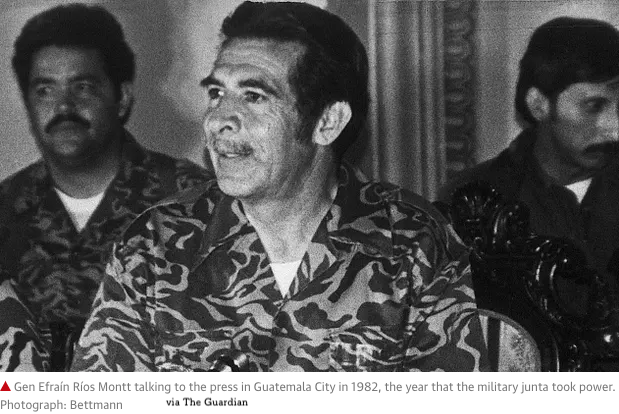
ホセ・エフライン・リオス・モント(José Efraín Ríos Montt, 1926-2018)

解説:池田光穂
リオス・モント(José Efraín Ríos Montt, 1926-2018):グアテマラの現代史には忘れることのできない軍人、政治家、大統領(第26代)である。国会議長の経験もあるが、1982年6月に 憲法を停止して軍事評議会議長から自ら大統領に就任した経験からは「将軍エフライン・リオス・モント」と国民から呼ばれていた。親米派の軍人としての長い 経験から国内の反政府ゲリラ掃討においてCIA仕込みの対ゲリラ戦術「低水準紛争」を実施し、グリーベレー顔負けの特殊部隊訓練、さらには住民を強制移住 させてゲリラの活動拠点を根絶やしにする「戦略村」などのベトナム戦争で考案された対ゲリラ戦術をCIAや米軍などからなる「軍事顧問団」などから導入し た。先住民の主食の一つであるインゲン豆との武器との地口である「銃とフリーホレス豆(Fusiles y Frijoles)」作戦の一環として、国軍に協力する地元の自警団(PAC)を組織させた。このために自分自身がクーデターで追われた後も、極右政党を 組織し、国民を二分するくらいの人気を博した。しかし国内外で執政時代の数々の責任(17件1,700人以上の虐殺を知りながら作戦を遂行)を問われるよ うになり、2013年有罪判決を受けたが、再審中の2018年4月1日に91歳で生涯を終えた(→『暴力の政治民族誌』「ホセ・エフライン・リオス・モント」)。
リンク先
文献
その他の情報
●リオス・モント(ウィキペディア・英語)
| José
Efraín Ríos
Montt (Spanish: [efɾaˈin ˈrios ˈmont]; 16 June 1926 – 1 April
2018) was
a Guatemalan military officer, politician, and dictator who served as
de facto President of Guatemala from 1982 to 1983. His brief tenure as
chief executive was one of the bloodiest periods in the long-running
Guatemalan Civil War. Ríos Montt's counter-insurgency strategies
significantly weakened the Marxist guerrillas organized under the
umbrella of the Guatemalan National Revolutionary Unity (URNG), while
also leading to accusations of war crimes and genocide perpetrated by
the Guatemalan Army under his leadership.[1][2] Ríos Montt was a career army officer. He was director of the Guatemalan military academy and rose to the rank of brigadier general. He was briefly chief of staff of the Guatemalan army in 1973, but was soon forced out of the position over differences with the military high command. He ran for president in the 1974 general election, losing to the official candidate General Kjell Laugerud in an electoral process widely regarded as fraudulent. In 1978, Ríos Montt controversially abandoned the Catholic Church and joined an Evangelical Christian group affiliated with the Gospel Outreach Church. In 1982, discontent with the rule of General Romeo Lucas García, the worsening security situation in Guatemala, and accusations of electoral fraud led to a coup d'état by a group of junior military officers who installed Ríos Montt as head of a government junta. Ríos Montt ruled as military dictator for less than seventeen months before he was overthrown in another coup led by his defense minister, General Óscar Mejía Victores. In 1989, Ríos Montt returned to the Guatemalan political scene as leader of a new political party, the Guatemalan Republican Front (FRG). He was elected many times to the Congress of Guatemala, serving as president of the Congress in 1995–96 and 2000–04. A constitutional provision prevented him from registering as a presidential candidate due to his involvement in the military coup of 1982, but the FRG obtained both the presidency and a congressional majority in the 1999 general election. Authorized by the Constitutional Court to run in the 2003 presidential elections, Ríos Montt came in third and withdrew from politics. He returned to public life in 2007 as a member of Congress, thereby gaining legal immunity from long-running lawsuits alleging war crimes committed by him and some of his ministers and counselors during their term in the presidential palace in 1982–83.[3][4] His immunity ended on 14 January 2012, when his legislative term of office expired. In 2013 a court sentenced Ríos Montt to 80 years in prison for genocide and crimes against humanity, but that sentence was quashed by the Constitutional Court and his retrial was never completed. |
ホセ・エフライン・リオス・モント(スペイン語: [efɾ
↪Laˈ]; 1926年6月16日 -
2018年4月1日)は、グアテマラの軍人、政治家、独裁者で、1982年から1983年までグアテマラの事実上の大統領を務めた。彼が最高行政官として
在任した短い期間は、長く続いたグアテマラ内戦の中でも最も血なまぐさい期間のひとつであった。リオス・モントの対反乱戦略は、グアテマラ民族革命統一
(URNG)の傘下に組織されたマルクス主義ゲリラを著しく弱体化させ、同時に彼の指導下でグアテマラ軍が行った戦争犯罪と大量虐殺の告発につながった
[1][2]。 リオス・モントは陸軍のキャリア将校であった。グアテマラ陸軍士官学校長を務め、准将まで昇進した。1973年に一時的にグアテマラ陸軍の参謀長を務めた が、軍上層部との意見の相違からすぐにその地位を追われた。1974年の総選挙では大統領選に出馬したが、不正選挙と広くみなされた選挙プロセスで公認候 補のキェル・ラウゲルード将軍に敗れた。1978年、リオス・モントはカトリック教会を棄教し、福音アウトリーチ教会に所属する福音主義キリスト教グルー プに参加し、物議を醸した。1982年、ロメオ・ルーカス・ガルシア将軍の統治に対する不満、グアテマラの治安状況の悪化、選挙不正の告発により、下級軍 人のグループによるクーデターが起こり、リオス・モントは政府軍団のトップに就任した。リオス・モントが軍事独裁者として統治したのは、国防相のオスカ ル・メヒア・ビクトレス将軍が率いる別のクーデターで倒されるまでの17ヵ月足らずだった。 1989年、リオス・モントは新政党グアテマラ共和国戦線(FRG)のリーダーとしてグアテマラの政界に復帰した。グアテマラ議会議員に何度も当選し、 1995-96年と2000-04年には議会議長を務めた。1982年の軍事クーデターに関与したため、憲法の規定により大統領候補として登録できなかっ たが、1999年の総選挙でFRGは大統領職と議会の過半数を獲得。2003年の大統領選挙では憲法裁判所から出馬を認められたが、3位に終わり、政界か ら引退した。2007年に議会議員として公の場に復帰し、1982年から83年にかけての大統領府在任中に彼と閣僚や顧問の一部が犯した戦争犯罪を主張す る長期にわたる訴訟から免責された[3][4]。2013年、裁判所はリオス・モントにジェノサイドと人道に対する罪で懲役80年の判決を下したが、この 判決は憲法裁判所によって破棄され、彼の再審が完了することはなかった。 |
| Early life and career Efraín Ríos Montt was born in 1926 in Huehuetenango, into a large family of the rural middle class. His father was a shopkeeper and his mother a seamstress, and the family also owned a small farm.[5] His younger brother Mario Enrique Ríos Montt became a Catholic priest and would serve as prelate of Escuintla and later as auxiliary bishop of the Archdiocese of Guatemala. Intent on making a career in the army, the young Efraín applied to the Polytechnic School (the national military academy of Guatemala), but was rejected because of his astigmatism. He then volunteered for the Guatemalan Army as a private, joining troops composed almost exclusively of full-blooded Mayas, until in 1946 he was able to enter the Polytechnic School.[6] Ríos Montt graduated in 1950 at the top of his class.[5] He taught at the Polytechnic School and received further specialized training, first at the U.S.-run officer training institute that would later be known as the School of the Americas, and later at Fort Bragg in North Carolina and the Italian War College.[7] From the start of his career, Ríos Montt acquired a reputation as a devoutly religious man and as a stern disciplinarian.[5] Ríos Montt did not play any significant role in the successful CIA-sponsored coup of 1954 against President Jacobo Arbenz.[5] He rose through the ranks of the Guatemalan army, and in 1970–72 served as director of the Polytechnic School.[8] In 1972, in the presidential administration of General Carlos Arana Osorio, Ríos Montt was promoted to brigadier general and in 1973 he became the Army's Chief of Staff (Jefe del Estado Mayor General del Ejército). However, he was removed from that post after three months and, much to his chagrin, dispatched to the Inter-American Defense College, in Washington, D.C.[5] According to anthropologist David Stoll, writing in 1990, Ríos Montt was "at odds with the army's command structure since being sidelined by military president Gen. Carlos Arana Osorio in 1974."[9] |
生い立ちと経歴 エフライン・リオス・モントは1926年、フエヘテナンゴの農村中産階級の大家族に生まれた。弟のマリオ・エンリケ・リオス・モントはカトリックの司祭と なり、エスクイントラの司教、後にグアテマラ大司教区の補助司教を務める。 若いエフラインは陸軍に入るつもりで、ポリテクニック・スクール(グアテマラの国立陸軍士官学校)を受験したが、乱視のため不合格となった。その後、二等 兵としてグアテマラ陸軍に志願し、1946年に工科学校に入学できるまで、ほとんど純血のマヤ人で構成された部隊に所属した[6]。 キャリアをスタートさせた当初から、敬虔な信心深さと厳格な規律主義者としての評判を得ていた[5]。 彼はグアテマラ陸軍で出世し、1970年から72年にかけて工科学校長を務めた[8]。1972年、カルロス・アラナ・オソリオ将軍の大統領政権で、リオ ス・モントは准将に昇進し、1973年には陸軍参謀総長となった。しかし、彼は3ヵ月後にそのポストから解任され、悔しさのあまりワシントンD.C.にあ る米州防衛大学に派遣された[5]。1990年に執筆した人類学者のデイヴィッド・ストールによれば、リオス・モントは「1974年にカルロス・アラナ・ オソリオ軍大統領によって傍流にされて以来、軍の指揮系統と対立していた」[9]。 |
| Early political involvement While in the US, Ríos Montt was approached by the leaders of the Guatemalan Christian Democracy with an invitation to run for president at the head of a coalition of parties opposed to the incumbent regime. Ríos Montt participated in the March 1974 presidential elections as the presidential candidate of the National Opposition Front (FNO). His running mate was Alberto Fuentes Mohr, a respected economist and social democrat. At the time, Ríos Montt was generally regarded as an honest and competent military man who could combat the rampant corruption in the Guatemalan government and armed forces.[10] In the run-up to the election, United States officials characterized the candidate Ríos Montt as a "capable left-of-center military officer" who would shift Guatemala "perceptibly but not radically to the left".[5] 1974 presidential elections The official candidate for the 1974 election was General Kjell Laugerud, whose running mate was Mario Sandoval Alarcón of the far-right National Liberation Movement. Pro-government posters warned "voters not to fall into a communist trap by supporting Ríos", but Ríos Montt proved to be an effective campaigner and most observers believe that his FNO won the popular vote by an ample majority.[5] According to the official tally, however, Ríos Montt lost the popular election by 71,000 votes to Laugerud. This result was widely seen as fraudulent, with the government halting the vote count on election night and manipulating the results to make it appear that Laugerud had obtained a narrow plurality.[5][8] Since Laugerud did not have an outright majority of the popular vote, the election was decided by the government-controlled National Congress, which chose Laugerud by a vote of 38 to 2, with 15 opposition deputies abstaining.[11] According to independent journalist Carlos Rafael Soto Rosales, Ríos Montt and the FNO leadership accepted the fraudulent outcome of the 1974 elections because they feared that a popular uprising "would result in disorder that would provoke worse government repression and that a challenge would lead to a confrontation between military leaders."[12] General Ríos Montt then left the country to take up an appointment as military attaché at the Guatemalan embassy in Madrid, where he remained until 1977.[8] It was rumored that the military high command paid Ríos Montt several hundred thousand dollars in exchange for his departure from public life and that during his exile in Spain his unhappiness led him to excessive drinking.[10] Religious conversion Ríos Montt retired from the army and returned to Guatemala in 1977. A spiritual crisis caused him to leave the Roman Catholic Church in 1978 and to join the Iglesia El Verbo ("Church of the Word"), an evangelical Protestant church affiliated with the Gospel Outreach Church based in Eureka, California.[13][14][15] Ríos Montt became very active in his new church and taught religion in a school affiliated with it. At the time, his younger brother Mario Enrique was the Catholic prelate of Escuintla. Efraín Ríos Montt's conversion has been interpreted as a significant event in the ascendency of Protestantism within the traditionally Catholic Guatemalan nation (see Religion in Guatemala). Ríos Montt later befriended prominent evangelists in the US, including Jerry Falwell and Pat Robertson.[16] |
初期の政治活動 米国滞在中、リオス・モントはグアテマラ・キリスト教民主主義の指導者たちから、現政権に反対する政党連合を率いて大統領選に出馬しないかという誘いを受 けた。1974年3月の大統領選挙に、リオス・モントは国民野党戦線(FNO)の大統領候補として参加した。彼の伴走者は、著名な経済学者で社会民主主義 者のアルベルト・フエンテス・モーアだった。当時、リオス・モントはグアテマラ政府と軍隊に蔓延する腐敗と闘うことができる誠実で有能な軍人であると一般 的にみなされていた[10]。選挙に向けた準備の中で、アメリカ政府高官はリオス・モント候補を「有能な中道左派の軍人」として特徴づけ、グアテマラを 「知覚できる程度には左派にシフトさせるだろうが、過激にはシフトさせないだろう」と述べた[5]。 1974年大統領選挙 1974年の選挙の公認候補はキェル・ラウゲルード将軍で、その伴走者は極右民族解放運動のマリオ・サンドバル・アラルコンだった。政府支持派のポスター は「有権者はリオスを支持することで共産主義者の罠にはまらないように」と警告したが、リオス・モントは効果的な選挙運動家であることが証明され、ほとん どのオブザーバーは彼のFNOが十分な多数決で人気投票を獲得したと考えている[5]。 しかし、公式集計では、リオス・モントは71,000票差でラウゲルドに敗れた。この結果は広く不正とみなされ、政府は選挙当日の夜に開票作業を中止し、 ラウゲルドが僅差で複数得票したかのように結果を操作した[5][8]。ラウゲルドは一般投票で完全な過半数を得ていなかったため、選挙は政府が支配する 国民議会によって決定され、国民議会は38対2の投票でラウゲルドを選出し、15人の野党議員が棄権した[11]。 独立系ジャーナリスト、カルロス・ラファエル・ソト・ロサレスによれば、リオス・モントとFNO指導部は、民衆蜂起が「無秩序を招き、政府の弾圧をさらに 悪化させ、挑戦が軍指導者間の対立につながる」ことを恐れたため、1974年の選挙の不正な結果を受け入れた。 「その後、リオス・モント将軍はマドリードのグアテマラ大使館の軍事担当官として任命されるために国を去り、1977年までそこに留まった[8]。軍上層 部は公の場から去ることと引き換えにリオス・モントに数十万ドルを支払ったという噂があり、スペインでの亡命中、彼の不幸は過度の飲酒につながった [10]。 宗教への改宗 1977年、リオス・モントは軍を引退し、グアテマラに戻った。1978年、精神的な危機からローマ・カトリック教会を去り、カリフォルニア州ユーレカに 本部を置くゴスペル・アウトリーチ教会に所属する福音主義プロテスタント教会であるイグレシア・エル・ヴェルボ(「御言葉の教会」)に入信した[13] [14][15]。当時、弟のマリオ・エンリケはエスクイントラのカトリック司祭であった。 エフライン・リオス・モントの改宗は、伝統的にカトリックであったグアテマラ国内でプロテスタントが台頭する重要な出来事であったと解釈されている(グア テマラの宗教を参照)。リオス・モントはその後、ジェリー・ファルウェルやパット・ロバートソンを含むアメリカの著名な伝道者と親交を深めた[16]。 |
| De facto presidency 1982 military coup The security situation in Guatemala had deteriorated under the government of General Romeo Lucas García, and by early 1982 the Marxist guerrilla groups belonging to the Guatemalan National Revolutionary Unity (URNG) umbrella organization had made gains in the countryside and were seen as threatening an attack on the capital, Guatemala City.[10] On March 7, 1982, General Ángel Aníbal Guevara, the official party's candidate, won the presidential election, a result denounced as fraudulent by all opposition parties. An informal group described as oficiales jóvenes ("young officers") then staged a military coup that overthrew Lucas and prevented Guevara from succeeding him as president.[8] On March 23, the coup culminated with the installation of a three-man military junta, presided by General Efraín Ríos Montt and composed also of General Horacio Maldonado Schaad and Colonel Luis Gordillo Martínez. Ríos Montt had not been directly involved in the planning of coup and was chosen by the oficiales jóvenes because of the respect that he had acquired as director of the military academy and as the presidential candidate of democratic opposition in 1974.[5] The events of March 1982 took the U.S. authorities by surprise.[17] Because of repeated vote-rigging and the blatant corruption of the military establishment, the 1982 coup was initially welcomed by many Guatemalans. Ríos Montt's reputation for honesty, his leadership of the opposition in the 1974 election, and his vision of "education, nationalism, an end to want and hunger, and a sense of civic pride" were widely appealing.[15] In April 1982, U.S. Ambassador Frederic L. Chapin declared that thanks to the coup of Ríos Montt, "the Guatemalan government has come out of the darkness and into the light",[18] though Chapin soon afterwards reported that Ríos Montt was "naïve and not concerned with practical realities".[19] Drawing on his Pentecostal beliefs, Ríos Montt compared the Four Horsemen of the Apocalypse to the four modern evils of hunger, misery, ignorance, and subversion. He also pledged to fight corruption and what he described as the depredations of the rich. Dictatorship The government junta immediately declared martial law and suspended the constitution, shut down the legislature, and set up special tribunals (tribunales de fuero especial) to prosecute both common criminals and political dissidents. On April 10, the junta launched the National Growth and Security Plan whose stated goals were to end indiscriminate violence and teach the populace about Guatemalan nationalism. The junta also announced that it sought to integrate peasants and indigenous peoples into the Guatemalan state, declaring that because of their illiteracy and "immaturity" they were particularly vulnerable to the seductions of "international communism."[citation needed] The government intensified its military efforts against the URNG guerrillas and, on April 20, 1982, launched a new counter-insurgency operation known as Victoria 82.[20] On June 9, General Ríos Montt forced the other two members of the junta to resign, leaving him as sole head of state, commander of the armed forces, and minister of defense. On 17 August 1982, Ríos Montt established a new Consejo de Estado ("Council of State") as an advisory body whose members were appointed either by the executive or by various civil associations.[21] This Council of State incorporated, for the first time in the history of the central Guatemalan government, several representatives of Guatemala's indigenous population.[22][23] Under the motto No robo, no miento, no abuso ("I don't steal, I don't lie, I don't abuse"), Ríos Montt launched a campaign ostensibly aimed at rooting out corruption in the government and reforming Guatemalan society. He also began to broadcast regular TV speeches on Sunday afternoons, known as discursos de domingo. According to historian Virginia Garrard-Burnett, It was in his Sunday sermons that Ríos Montt explicated the moral roots of Guatemala's many problems and limned the outlines of his political and moral imaginaire. Although ridiculed both at home and abroad for their preachy and even naive tone (earning the General the derisive nickname "Dios Montt"), the discursos nonetheless bore an internally cohesive message that clearly laid out Ríos Montt's diagnosis of the crisis and his idiosyncratic vision for national redemption. In the General's view, Guatemala suffered from three fundamental problems: a national lack of responsibility and respect for authority, an absolute lack of morality, and an inchoate sense of national identity. All other issues, from the economic crisis to what Ríos Montt called the "subversion," were merely symptoms of these three fundamental ills.[24] Ríos Montt's moralizing message continued to resonate with a significant part of Guatemalan society after he departed from power in 1983. In 1990, anthropologist David Stoll quoted a development organizer who told him that she liked Ríos Montt "because he used to get on television, point his finger at every Guatemalan, and say: 'The problem is you!' That's the only way this country is ever going to change."[9] |
事実上の大統領職 1982年軍事クーデター グアテマラの治安情勢はロメオ・ルーカス・ガルシア将軍の政権下で悪化し ており、1982年初頭にはグアテマラ民族革命統一(URNG)傘下のマルクス主 義ゲリラ・グループが地方で勢力を伸ばし、首都グアテマラ・シティを攻撃する恐れがあると見られていた[10]。 1982年3月7日、公党候補のアンヘル・アニバル・ゲバラ将軍が大統領選挙に勝利したが、この結果はすべての野党によって不正であると非難された。その 後、oficiales jóvenes(「青年将校」)と呼ばれる非公式グループが軍事クーデターを起こし、ルーカスを打倒し、ゲバラが大統領の座を継ぐのを阻止した[8]。 3月23日、クーデターは、エフライン・リオス・モント将軍を議長とし、オラシオ・マルドナド・シャード将軍とルイス・ゴルディージョ・マルティネス大佐 からなる3人の軍事政権を発足させることで頂点に達した。リオス・モントはクーデターの計画には直接関与しておらず、1974年に陸軍士官学校の校長とし て、また民主的野党の大統領候補として尊敬を集めていたため、ジョベネス党員によって選ばれた[5]。1982年3月の出来事はアメリカ当局を驚かせた [17]。 度重なる不正投票と軍部組織のあからさまな腐敗のため、1982年のクーデターは当初多くのグアテマラ人に歓迎された。リオス・モントの誠実さに対する評 判、1974年の選挙における野党の指導力、そして「教育、ナショナリズム、欠乏と飢餓の撲滅、市民の誇り」という彼のビジョンは広くアピールされた [15]。チャピンは、リオス・モントのクーデターのおかげで、「グアテマラ政府は暗闇から光の中に出てきた」と宣言したが[18]、チャピンはその後す ぐに、リオス・モントは「ナイーブで、現実的な現実に関心がない」と報告した[19]。 彼のペンテコステ派の信念に基づき、リオス・モントは、黙示録の四騎士を飢餓、悲惨、無知、破壊の4つの現代の悪になぞらえた。また、汚職や富裕層の横領 と闘うことを誓った。 独裁政権 政府軍政は直ちに戒厳令を布告し、憲法を停止し、立法府を閉鎖し、常習犯と反体制派を訴追する特別法廷(tribunales de fuero especial)を設置した。4月10日、グアテマラ政権は、無差別暴力をなくし、国民にグアテマラのナショナリズムを教えることを目的とした「国家成 長・治安計画」を発表した。政府はURNGゲリラに対する軍事的取り組みを強化し、1982年4月20日にはビクトリア82として知られる新たな対反乱作 戦を開始した[20]。 6月9日、リオス・モント将軍は他の2人の政権メンバーを辞任に追い込み、彼を唯一の国家元首、軍司令官、国防大臣とした。1982年8月17日、リオ ス・モントは諮問機関として新たなコンセホ・デ・エスタド(「国家評議会」)を設立し、そのメンバーは行政府または様々な市民団体によって任命された [21]。この国家評議会には、グアテマラ中央政府の歴史上初めて、グアテマラの先住民の代表数名が組み込まれた[22][23]。 No robo, no miento, no abuso(「私は盗まない、嘘をつかない、虐待しない」)をモットーに、リオス・モントは表向きは政府の腐敗を根絶し、グアテマラ社会を改革することを 目的としたキャンペーンを開始した。彼はまた、discursos de domingoとして知られる日曜日の午後に定期的にテレビ演説を放送し始めた。歴史家のヴァージニア・ガラード=バーネットによれば リオス・モントがグアテマラの多くの問題の道徳的根源を説明し、彼の政治的・道徳的イマジネアの輪郭を描いたのは、日曜日の説教だった。その説教的で素朴 な口調(将軍は「ディオス・モント」という嘲笑的なあだ名で呼ばれた)から国内外で嘲笑されたが、それでも説教には、危機に対するリオス・モントの診断と 国家救済のための彼の特異なビジョンを明確に示す、内面的にまとまったメッセージが込められていた。将軍の見解では、グアテマラは3つの根本的な問題に苦 しんでいた。責任感の欠如と権威への敬意、道徳の絶対的欠如、そして国民的アイデンティティの未解決な感覚である。経済危機からリオス・モントが「破壊」 と呼んだものまで、他のすべての問題はこれら3つの根本的な悪の症状に過ぎなかった[24]。 リオス・モントの道徳的なメッセージは、彼が1983年に権力を去った後も、グアテマラ社会のかなりの部分と共鳴し続けた。1990年、人類学者のデイ ヴィッド・ストールは、リオス・モントが好きだったというある開発オーガナイザーの言葉を引用し、「彼がテレビに出て、すべてのグアテマラ人を指さし、 『問題はお前だ!』と言ったからだ。それがこの国を変える唯一の方法なのです」[9]。 |
| Counter-insurgency: Fusiles y
Frijoles See also: Guatemalan genocide § Genocide under Ríos Montt Violence escalated in the countryside under the Guatemalan military's plan Victoria 82, which included a rural pacification strategy known as Fusiles y Frijoles (lit. 'Rifles and beans'), often rendered into English as "beans and bullets" to preserve the alliteration of the original. The "bullets" referred to the organization of the Civil Defense Patrols (Patrullas de Autodefensa Civil, PAC), composed primarily of indigenous villagers who patrolled in groups of twelve, usually armed with a single M1 rifle and sometimes not armed at all.[25] The PAC initiative was intended both to provide a pro-government presence in isolated rural villages with a majority Mayan population, and to deter guerrilla activity in the area. The "beans" component of the counter-insurgency strategy referred to programs seeking to increase civilian-military contact and cooperation by improving the infrastructure and resources that the government provided to the Mayan villages. This was meant to create a link in the minds of the indigenous and peasant communities between better access to resources and their own cooperation with the Guatemalan government in its military struggle against the insurgents.[25] General Ríos Montt's government announced an amnesty in June 1982 for all insurgents willing to lay down their arms. That was followed a month later by the declaration of a state of siege, curtailing the activities of political parties and labor unions, under the threat of death by firing squad for subversion.[26] Critics have argued that, in practice, Ríos Montt's strategy amounted to a scorched earth campaign targeted against the indigenous Maya population, particularly in the departments of Quiché, Huehuetenango, and Baja Verapaz. According to the 1999 report by the UN-sponsored Historical Clarification Commission (CEH), this resulted in the annihilation of nearly 600 villages. One instance was the Plan de Sánchez massacre in Rabinal, Baja Verapaz, in July 1982, which saw over 250 people killed. Tens of thousands of peasant farmers fled over the border into southern Mexico. In 1982, an Amnesty International report estimated that over 10,000 indigenous Guatemalans and peasant farmers were killed from March to July of that year, and that 100,000 rural villagers were forced to flee their homes.[27] According to more recent estimates presented by the CEH, tens of thousands of non-combatants were killed during Ríos Montt's tenure as head of state. At the height of the bloodshed, reports put the number of disappearances and killings at more than 3,000 per month.[28] The 1999 book State Violence in Guatemala, 1960–1996: A Quantitative Reflection, published by the American Association for the Advancement of Science, states that Rios Montt's government presided over "the most indiscriminate period of state terror. More state killings occurred during Ríos Montt’s regime than during any other, and in the same period the monthly rate of violence was more than four times greater than for the next highest regime."[29] On the other hand, the United Nations special rapporteur for the situation of human rights in Guatemala, Lord Colville of Culross, wrote in 1984 that the lot of the rural population of Guatemala had improved under Ríos Montt, as the previous indiscriminate violence of the Guatemalan Army was replaced by a rational strategy of counter-insurgency. Colville also indicated that extrajudicial "killings and kidnappings virtually ceased under the Ríos Montt regime".[22] According to anthropologist David Stoll, "the crucial difference" between Ríos Montt and his predecessor Lucas García was that Ríos Montt replaced "chaotic terror with a more predictable set of rewards and punishments".[30] According to analysts Georges A. Fauriol and Eva Loser of the Center for Strategic and International Studies, "an important component in the 'normalization' of the Guatemalan environment was a marked decrease by late 1982 in the state of fear and violence, which allowed the repositioning of Guatemala's civilian urbanized leadership toward a more vital role in national affairs."[31] Sociologist and historian Carlos Sabino, in a work originally published in 2007 by the Fondo de Cultura Económica, noted that the army's counter-insurgency in the Guatemalan highlands had been launched at the end of 1981, before the coup that put Ríos Montt in power, and that the reported massacres peaked in May 1982 before dropping off rapidly as a consequence of the policies implemented by the Ríos Montt regime.[32] According to Sabino, the guerrillas were effectively defeated by the PACs organized by Ríos Montt's regime, which grew to involve 900,000 men and which, "though only very partially armed, completely took away the guerrilla's capacity for political action", as they could no longer "reach the villages and towns, organize rallies, or recruit fighters and collaborators among the peasants."[33] According to French sociologist Yvon Le Bot, writing in 1992, Ríos Montt won a decisive victory over a guerrilla force already weakened by the blows landed upon it by General Benedicto Lucas during the last months of his brother's government. Since then, he is, more than the Lucas brothers, the bête noire of the revolutionaries who do not forgive him for having consummated their defeat by turning their own weapons against them and in particular by the appeal to the moral and religious sentiments so profoundly rooted among the Guatemalan Mayas.[34] In a similar vein, historian Virginia Garrard-Burnett concluded in 2010 that General Ríos Montt's military's successes "were unprecedented in Guatemala’s modern history" and that, "had the Cold War remained the primary lens of historical analysis, [he] might well be remembered as a visionary statesman instead of an author of crimes against humanity."[35] Even some of Ríos Montt's harshest critics have noted that, in his later political career during the 1990s and 2000s, he enjoyed particularly strong and enduring electoral support in the departments of Quiché, Huehuetenango, and Baja Verapaz, which had seen the worst violence during the 1982–83 counter-insurgency campaign.[36][37][38] According to David Stoll, "the most obvious reason Nebajeños like the former general is that he offered them the chance to surrender without being killed."[9] Support from US and Israel In 1977, the Carter administration had suspended aid by the United States to Guatemala, due to the grave violations of human rights by the Guatemalan government.[39] In 1981, the new Reagan administration authorized the sale to the Guatemalan military of $4 million in helicopter spare parts and $6.3 million in additional military supplies, to be shipped in 1982 and 1983.[40][41][42][43][44] President Ronald Reagan traveled to Central America in December 1982. He did not visit Guatemala, but met with Efraín Ríos Montt in San Pedro Sula, Honduras, on December 4, 1982. During that meeting, General Ríos Montt reassured Reagan that the Guatemalan government's counter-insurgency strategy was not one of "scorched earth", but rather of "scorched Communists", and pledged to work to restore the democratic process in the country.[45] Reagan then declared: "President Ríos Montt is a man of great personal integrity and commitment... I know he wants to improve the quality of life for all Guatemalans and to promote social justice."[46][47] Guatemala's poor record on human rights and the refusal of General Ríos Montt to call immediately for new elections prevented the Reagan administration from restoring US aid to Guatemala, which would have required the consent of the US Congress.[48] The Reagan administration did continue the sale of helicopter parts to the Guatemalan military, even though a then-secret 1983 CIA cable noted a rise in "suspect right-wing violence" and an increasing number of bodies "appearing in ditches and gullies."[49] Israel, which had been supplying arms to Guatemala since 1974, continued its aid provisions during Ríos Montt's government. The cooperation did not just involve hardware, but also included providing intelligence and operational training, carried out both in Israel and in Guatemala. In 1982, Ríos Montt told ABC News that his success was due to the fact that "our soldiers were trained by Israelis." There was not much outcry in Israel at the time about its involvement in Guatemala, though the support for Ríos Montt was no secret. According to journalist Victor Perera, in 1985 at a cemetery in Chichicastenango, relatives of a man killed by the military told him that "in church they tell us that divine justice is on the side of the poor; but the fact of the matter is, it is the military who get the Israeli guns."[50] Removal from power By the end of 1982, Ríos Montt, claiming that the war against the leftist guerrillas had been won, said the government's work was one of "techo, trabajo, y tortillas" ("roofs, work, and tortillas"). Having survived three attempted coups, on June 29, 1983, Ríos Montt declared a state of emergency and announced elections for July 1984. By then Ríos Montt had alienated many segments of Guatemalan society by his actions. Shortly before the visit to Guatemala by Pope John Paul II in March 1983, Ríos Montt refused the Pope's appeal for clemency to six guerrillas who had been sentenced to death by the regime's special tribunals.[51] The outspoken evangelicalism and the moralizing sermons of the general's regular Sunday television broadcasts (discursos de domingo) were increasingly regarded with embarrassment by many.[10] The military brass was offended by his promotion of young officers in defiance of the Army's traditional hierarchy. Many middle class citizens were unhappy with the decision, announced on August 1, 1983, to introduce the value-added tax for the first time in Guatemalan history. One week later, on August 8, 1983, his own Minister of Defense, General Óscar Mejía Victores, overthrew the regime in a coup during which seven people were killed.[52] The leaders of the 1983 coup alleged that Ríos Montt belonged to a "fanatical and aggressive religious group" that had threatened the "fundamental principle of the separation of Church and State".[53] However, historian Virginia Garrard-Burnett considered that the main underlying reason for his removal from power was that Ríos Montt "had severely stanched the flow of graft to military officers and government officials" and was not responsive to the powerful interest groups represented by the Army's high command.[54] Political violence in Guatemala continued after Ríos Montt was removed from power in 1983.[55][56] It has been estimated that as many as one and a half million Maya peasants were uprooted from their homes.[57] American journalist Vincent Bevins writes that by corralling indigenous populations from suspect communities into state-established "model villages" (aldeas modelos) that were "little more than deadly concentration camps," Ríos Montt waged genocide in a different fashion than his predecessors, although massacres continued apace. This, Bevins argues, was part of Montt's new strategy for fighting communism: "The guerrilla is the fish. The people are the sea. If you cannot catch the fish, you have to drain the sea."[58] Efraín Ríos Montt's sister Marta Elena Ríos de Rivas was kidnapped on 26 June 1983 in Guatemala City by members of the leftist Rebel Armed Forces (FAR), when she was leaving the primary school where she worked as a teacher. At the time she was five months pregnant. After General Ríos Montt was deposed in August of that year, the FAR proceeded to kidnap the sister of the new de facto president, General Mejía Víctores. The new government flatly refused to negotiate with the kidnappers, but the family of General Ríos Montt obtained the release of his sister Marta on 25 September, after 119 days in captivity, by procuring the publication of an FAR comuniqué in several international newspapers.[59] |
対反乱戦 フシレスとフリホーレス も参照: グアテマラ虐殺§リオス・モント政権下の虐殺 グアテマラ軍のビクトリア82計画の下で、暴力は地方でエスカレートした。ビクトリア82計画には、フシレス・イ・フリホーレス(小銃と豆)として知られ る地方平定戦略が含まれていた。弾丸」は民間防衛パトロール隊(Patrullas de Autodefensa Civil, PAC)の組織を指し、主に先住民の村民で構成され、12人のグループでパトロールを行い、通常はM1ライフル1丁で武装し、武装していないこともあった [25]。対反乱戦略の「豆」の要素は、政府がマヤの村に提供するインフラや資源を改善することによって、民間人と軍との接触や協力を増やそうとするプロ グラムを指していた。これは、先住民や農民のコミュニティの心の中に、資源へのより良いアクセスと、反政府勢力との軍事闘争におけるグアテマラ政府との彼 ら自身の協力とのつながりを作り出すことを意図していた[25]。 リオス・モント将軍の政府は1982年6月、武器を捨てる意思のあるすべての反乱軍に対する恩赦を発表した。その1ヵ月後には包囲状態が宣言され、国家転 覆罪による銃殺刑という脅しのもと、政党や労働組合の活動が制限された[26]。 批評家たちは、実際には、リオス・モントの戦略は、特にキチェ県、ウエウエテナンゴ県、バハ・ベラパス県における先住民マヤ族を標的とした焦土作戦に等し かったと主張している。国連主催の歴史解明委員会(CEH)の1999年の報告書によると、この結果、600近い村が消滅した。その一例が、1982年7 月にバハ・ベラパスのラビナルで起きたプラン・デ・サンチェスの虐殺で、250人以上が殺された。何万人もの農民が国境を越えてメキシコ南部に逃亡した。 1982年、アムネスティ・インターナショナルの報告書は、その年の3月から7月までに1万人以上のグアテマラ先住民や農民が殺害され、10万人の農村住 民が故郷を追われたと推定した[27]。流血の最盛期には、失踪と殺害の数は月に3,000人以上であったと報告されている[28]: American Association for the Advancement of Science(アメリカ科学振興協会)が出版した1999年の著書『State Violence in Guatemala, 1960-1996: A Quantitative Reflection(グアテマラにおける国家暴力、1960-1996:定量的考察)』は、リオス・モント政権が「最も無差別な国家テロの時代」を主宰 したと述べている。リオス・モントの政権時代には、他のどの政権時代よりも多くの国家的殺戮が発生し、同時期の月別暴力発生率は、次に高い政権の4倍以上 であった」[29]。 他方、グアテマラの人権状況に関する国連の特別報告者であるカルロスのコルヴィル卿は、1984年に、グアテマラ軍の以前の無差別暴力が対反乱の合理的な 戦略に取って代わられたため、グアテマラの農村住民の境遇はリオス・モントの下で改善されたと書いている。コルヴィルはまた、超法規的な「殺害と誘拐がリ オス・モント政権下で事実上なくなった」と指摘した[22]。 人類学者のデイヴィッド・ストールによれば、リオス・モントとその前任者ルーカス・ガルシアとの「決定的な違い」は、リオス・モントが「混沌とした恐怖 を、より予測可能な報酬と罰のセットに置き換えた」ことであった[30]。戦略国際問題研究センターのアナリスト、ジョルジュ・A・フォーリオルとエ ヴァ・ローサーによれば、「グアテマラの環境の『正常化』における重要な要素は、1982年後半までに恐怖と暴力の状態が顕著に減少したことであり、これ によってグアテマラの都市化された文民の指導者が国政においてより重要な役割を果たすように再配置された」[31]。 社会学者であり歴史家であるカルロス・サビノ(Carlos Sabino)は、Fondo de Cultura Económicaから2007年に出版された著作の中で、グアテマラ高地における軍隊の反乱活動は、リオス・モント(Ríos Montt)を政権に就けたクーデターの前の1981年末に開始され、報告された虐殺は1982年5月にピークに達した後、リオス・モント政権によって実 施された政策の結果として急速に減少したと指摘している。 [32] サビノによれば、ゲリラはリオス・モント政権によって組織されたPACによって事実上敗北し、90万人の兵士を巻き込むまでに成長し、「ごく部分的に武装 しただけではあったが、ゲリラの政治的行動能力を完全に奪った」、 リオス・モントは、兄の政権の最後の数カ月間にベネディクト・ルーカス将軍が与えた打撃によってすでに弱体化していたゲリラ部隊に決定的な勝利を収めた。 それ以来、彼はルーカス兄弟以上に、自分たちの武器を自分たちに向け、特にグアテマラ・マヤの間に深く根付いている道徳的、宗教的感情に訴えることによっ て、自分たちの敗北を完成させたことを許さない革命家たちの憎むべき存在である[34]。 同様の流れで、歴史家のヴァージニア・ガラード=バーネットは2010年に、リオス・モント将軍の軍の成功は「グアテマラの近代史において前例がない」も のであり、「冷戦が歴史分析の主要なレンズであり続けていたならば、(彼は)人道に対する罪の作者ではなく、先見の明のある政治家として記憶されたかもし れない」と結論づけた[35]。 リオス・モントの最も厳しい批評家の一部でさえ、1990年代から2000年代にかけての彼の政治的キャリアにおいて、1982年から83年にかけての対 反乱キャンペーンで最悪の暴力を経験したキチェ県、フエウエテナンゴ県、バハ・ベラパス県において、彼が特に強力で永続的な選挙支持を享受していたことを 指摘している[36][37][38]。 デヴィッド・ストールによれば、「ネバジェーニョが元将軍を好む最も明白な理由は、彼が殺されずに降伏するチャンスを彼らに提供したからである」[9]。 アメリカとイスラエルからの支援 1977年、カーター政権はグアテマラ政府による重大な人権侵害を理由に、アメリカによるグアテマラへの援助を停止していた[39]。1981年、レーガ ン新政権はグアテマラ軍にヘリコプターのスペアパーツ400万ドルと追加軍事物資630万ドルの販売を許可し、1982年と1983年に出荷した[40] [41][42][43][44]。 ロナルド・レーガン大統領は1982年12月に中米を訪問。グアテマラは訪問しなかったが、1982年12月4日にホンジュラスのサンペドロスーラでエフ ライン・リオス・モントと会談した。この会談でリオス・モント将軍は、グアテマラ政府の対反乱戦略は「焦土化」ではなく、むしろ「共産主義者の焦土化」で あるとレーガンを安心させ、国内の民主化プロセスの回復に取り組むことを約束した[45]: 「リオス・モント大統領は非常に誠実で献身的な人物だ。私は彼がすべてのグアテマラ人の生活の質を向上させ、社会正義を促進したいと考えていることを知っ ている」[46][47]。 グアテマラの人権に関する劣悪な記録と、リオス・モント将軍が直ちに新しい選挙を要求することを拒否したため、レーガン政権はアメリカ議会の同意を必要と するグアテマラへのアメリカからの援助を回復することができなかった[48]。 レーガン政権は、1983年のCIAの極秘公電に「疑惑の右翼による暴力」の増加と「溝や側溝に現れる」死体の数の増加が記されていたにもかかわらず、グ アテマラ軍へのヘリコプター部品の販売を継続した[49]。 1974年からグアテマラに武器を供給していたイスラエルは、リオス・モント政権時代も援助供与を続けた。この協力は単にハードウェアを含むだけでなく、 イスラエルとグアテマラの両方で実施された情報提供や作戦訓練も含んでいた。1982年、リオス・モントはABCニュースに対し、彼の成功は "我々の兵士がイスラエル人によって訓練された "という事実によるものだと語った。当時イスラエルでは、グアテマラへの関与についてそれほど大きな反発はなかったが、リオス・モントへの支援は周知の事 実だった。ジャーナリストのビクトル・ペレラによれば、1985年にチチカステナンゴの墓地で、軍に殺された男の親族が「教会では神の正義は貧しい者の側 にあると言われるが、実際のところ、イスラエルの銃を手にするのは軍だ」と語ったという[50]。 権力からの排除 1982年末までに、リオス・モントは左翼ゲリラとの戦争に勝利したと主張し、政府の仕事は「屋根、労働、トルティーヤ」(techo, trabajo, y tortillas)であると述べた。3度のクーデター未遂を乗り越え、1983年6月29日、リオス・モントは非常事態を宣言し、1984年7月の選挙 を発表した。その時までに、リオス・モントはその行動によってグアテマラ社会の多くの層を疎外した。1983年3月に教皇ヨハネ・パウロ2世がグアテマラ を訪問する直前、リオス・モントは政権の特別法廷によって死刑判決を受けた6人のゲリラに対する教皇の慈悲の訴えを拒否した。 [51] 将軍が定期的に日曜日に放送していたテレビ番組(discursos de domingo)の率直な福音主義や道徳的な説教は、多くの人々から恥ずかしく思われるようになっていた[10]。軍の上層部は、陸軍の伝統的なヒエラル キーに逆らって若い将校を昇進させたことに腹を立てていた。1983年8月1日に発表された、グアテマラ史上初の付加価値税導入の決定には、多くの中産階 級市民が不満を抱いた。その1週間後の1983年8月8日、自身の国防大臣であったオスカル・メヒア・ビクトレス将軍がクーデターで政権を転覆させ、7人 が殺害された[52]。 1983年のクーデターの指導者たちは、リオス・モントが「政教分離の基本原則」を脅かした「狂信的で攻撃的な宗教グループ」に属していると主張した [53]。しかし、歴史家のヴァージニア・ガラード=バーネットは、彼の権力からの排除の主な根本的な理由は、リオス・モントが「軍将校や政府高官への接 待の流れを厳しく食い止めていた」こと、そして陸軍の最高司令部に代表される強力な利益団体に対応していなかったことであると考えた[54]。 グアテマラにおける政治的暴力は、1983年にリオス・モントが政権から解任された後も続いた[55][56]。 [57]アメリカ人ジャーナリストのヴィンセント・ベヴィンズは、先住民を容疑者のコミュニティから「死の強制収容所に過ぎない」国が設立した「モデル 村」(aldeas modelos)に集めることで、リオス・モントは前任者とは異なるやり方で大量虐殺を行ったが、虐殺は絶え間なく続いたと書いている。ゲリラは魚だ。ゲ リラは魚。ゲリラは魚であり、民衆は海である。魚を捕ることができなければ、海から水を排出しなければならない」[58]。 エフライン・リオス・モントの妹マルタ・エレナ・リオス・デ・リバスは、1983年6月26日、グアテマラ・シティで、教師として働いていた小学校を去ろ うとしたところを、左翼反乱軍(FAR)のメンバーによって誘拐された。当時、彼女は妊娠5カ月だった。その年の8月にリオス・モント将軍が退陣した後、 FARは事実上の新大統領メヒア・ビクトレス将軍の妹の誘拐を進めた。新政府は誘拐犯との交渉をきっぱりと拒否したが、リオス・モント将軍の家族は、いく つかの国際新聞にFARのコミュニケを掲載させることによって、119日間拘束された後、9月25日に妹のマルタの解放を勝ち取った[59]。 |
| Later political career Logo of the Frente Republicano Guatemalteco (FRG, "Guatemalan Republican Front") founded by General Ríos Montt in 1989 and officially registered in 1990. The logo is based on an image used by the military government in 1982–83 and tied to the motto No robo, no miento, no abuso ("I don't steal, I don't lie, I don't abuse"). Here the motto has been changed to Seguridad, bienestar, justicia ("Security, welfare, justice"). 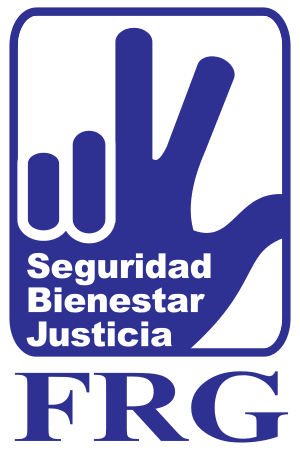 Ríos Montt founded
the Guatemalan Republican Front (FRG) political party in 1989. In the
run-up to the 1990 general election, polls indicated that Ríos Montt
was the most popular candidate, leading his nearest rival by as many as
twelve points.[9] He was ultimately prevented from appearing in the
ballots by the courts because of a provision in the 1985 Constitution
of Guatemala that banned people who had participated in a military coup
from becoming president. Ríos Montt always claimed that the
corresponding article had been written into the Constitution
specifically to prevent him from returning to the Presidency and that
it could not legitimately be applied retroactively. Ríos Montt founded
the Guatemalan Republican Front (FRG) political party in 1989. In the
run-up to the 1990 general election, polls indicated that Ríos Montt
was the most popular candidate, leading his nearest rival by as many as
twelve points.[9] He was ultimately prevented from appearing in the
ballots by the courts because of a provision in the 1985 Constitution
of Guatemala that banned people who had participated in a military coup
from becoming president. Ríos Montt always claimed that the
corresponding article had been written into the Constitution
specifically to prevent him from returning to the Presidency and that
it could not legitimately be applied retroactively.In the 1990s Ríos Montt enjoyed significant popular support throughout Guatemala and especially among the native Maya population of the departments of Quiché, Huehuetenango, and Baja Verapaz, where he was perceived as un militar recto (an honest military man),[9][10] even though those had been the populations most directly affected by the counter-insurgency that Ríos Montt had led in 1982–83.[5] According to anthropologist David Stoll Ríos Montt's popularity was difficult to comprehend for most scholars and journalists because they have been so deeply influenced by human rights and solidarity work [...] The most influential literature on Guatemala has been written by activists, the majority of whom are also academics. Generally, this literature has been slow to admit the defeat of the guerrillas in 1982, their subsequent lack of popular support, and contradictions in the human rights movement.[60] According to political scientist Regina Bateson, in this new phase of his career Ríos Montt embraced populism as his core political strategy.[5] He was an FRG congressman between 1990 and 2004. In 1994, he was elected president of the unicameral legislature. He tried to run again in the 1995–96 Guatemalan general election, but was barred from entering the race. Alfonso Portillo was chosen to replace Ríos Montt as the FRG's presidential candidate, and he narrowly lost to Álvaro Arzú of the conservative National Advancement Party. In his youth, Portillo had been affiliated with the Guerrilla Army of the Poor (EGP), one of the Marxist insurgent groups that later became part of the Guatemalan National Revolutionary Unity (URNG) and which Ríos Montt had combated during his term as president in 1982–83.[5] The Guatemalan Civil War officially concluded in 1996 with the signing of the peace accords between the Guatemalan government and the URNG, who thereafter organized as a legal political party. In March 1999, U.S. President Bill Clinton declared that "for the United States, it is important I state clearly that support for military forces and intelligence units which engaged in violence and widespread repression [in Guatemala] was wrong and the United States must not repeat that mistake."[61] Ríos Montt's FRG party was successful in the 1999 Guatemalan general election. Its candidate, Alfonso Portillo, was elected president and the party also obtained a majority in the National Congress. Ríos Montt then served four consecutive one-year terms as president of Congress, from 2000 to 2004. President Portillo admitted the involvement of the Guatemalan government in human rights abuses over the previous 20 years, including two massacres that took place during Ríos Montt's presidency. The first was in Plan de Sánchez, in Baja Verapaz, with 268 dead, and in Dos Erres in Petén, where 200 people were murdered.[citation needed] 2003 presidential candidate In May 2003 the FRG nominated Ríos Montt for the November presidential election, but his candidacy was rejected again by the electoral registry and by two lower courts. On 14 July 2003, the Constitutional Court, which had had several judges appointed by the FRG government, approved his candidacy for president on the grounds that the prohibition in the 1985 Constitution did not apply retroactively. On 20 July the Supreme Court suspended Ríos Montt's campaign and agreed to hear a complaint brought by two right-of-centre parties that the general was constitutionally barred from running for president. Ríos Montt denounced the ruling as a judicial manipulation and, in a radio address, called on his followers to take to the streets to protest against it. On 24 July, in an event that came to be known as jueves negro ("Black Thursday"), thousands of masked FRG supporters invaded the streets of Guatemala City, armed with machetes, clubs, and guns. They had been bussed in from all over the country by the FRG, and it was alleged that public employees in FRG-controlled municipalities were threatened with the loss of their jobs if they did not participate in the demonstrations. The protestors blocked traffic, chanted threatening slogans, and waved machetes as they marched on the courts, the opposition parties' headquarters, and newspapers. Incidents of torching of buildings, shooting out of windows, and burning of cars and tires in the streets were also reported. A television journalist, Héctor Fernando Ramírez, died of a heart attack while running away from a mob. After two days the rioters disbanded when an audio recording of Ríos Montt was played in loudspeakers calling them to return to their homes. The situation was so volatile over the weekend that both the UN mission and the US embassy were closed. Following the rioting, the Constitutional Court overturned the Supreme Court decision, allowing Ríos Montt to run for president. However, the jueves negro chaos undermined Ríos Montt's popularity and his credibility as a law-and-order candidate. Support for Ríos Montt also suffered because of the perceived corruption and inefficiency of the incumbent FRG administration under President Portillo.[5] During tense but peaceful presidential elections on November 9, 2003, Ríos Montt received 19.3% of the vote, placing him third behind Óscar Berger, head of the conservative Grand National Alliance (GANA), and Álvaro Colom of the center-left National Unity of Hope (UNE). As he had been required to give up his seat in Congress to run for president, Ríos Montt's 14-year legislative tenure also came to an end. In March 2004, a court order forbade Ríos Montt from leaving the country while it determined whether he should stand trial on charges related to jueves negro and the death of Ramírez. On November 20, 2004, Ríos Montt had to request permission to travel to his country home for the wedding of his daughter Zury Ríos, to U.S. Representative Jerry Weller, a Republican from Illinois.[62] On January 31, 2006, manslaughter charges against him for the death of Ramírez were dropped. |
その後の政治活動 1989年にリオス・モント将軍によって創設され、1990年に正式に登録されたグアテマラ共和国戦線(FRG)のロゴ。ロゴは1982年から83年にか けて軍事政権が使用していたイメージに基づいており、「No robo, no miento, no abuso」(「私は盗まない、嘘をつかない、虐待しない」)というモットーと結びついている。このモットーは、「安全、福祉、正義」 (Seguridad, bienestar, justicia)に変更された。  リオス・モントは1989年にグアテマラ共和国
戦線(FRG)政党を設立。1990年の総選挙に向けた世論調査では、リオス・モントは最も人気のある候補者であり、最も近いライバルを12ポイントも
リードしていた[9]。
1985年のグアテマラ憲法には、軍事クーデターに参加した者が大統領になることを禁止する規定があったため、最終的に彼は裁判所によって投票に参加する
ことができなかった。リオス・モントは常に、この条項は自分が大統領に返り咲くのを阻止するために特別に憲法に書き込まれたものであり、遡及して合法的に
適用することはできないと主張していた。 リオス・モントは1989年にグアテマラ共和国
戦線(FRG)政党を設立。1990年の総選挙に向けた世論調査では、リオス・モントは最も人気のある候補者であり、最も近いライバルを12ポイントも
リードしていた[9]。
1985年のグアテマラ憲法には、軍事クーデターに参加した者が大統領になることを禁止する規定があったため、最終的に彼は裁判所によって投票に参加する
ことができなかった。リオス・モントは常に、この条項は自分が大統領に返り咲くのを阻止するために特別に憲法に書き込まれたものであり、遡及して合法的に
適用することはできないと主張していた。1990年代、リオス・モントはグアテマラ全土で、特にキチェ県、ウエウエテナンゴ県、バハ・ベラパス県の先住民マヤ族の間で大きな支持を得ており、彼は 1982年から83年にかけてリオス・モントが率いた反乱によって最も直接的に影響を受けた住民であったにもかかわらず、un militar recto(正直な軍人)として認識されていた[9][10]。 グアテマラに関する最も影響力のある文献は活動家によって書かれたものであり、その大多数は学者でもある。一般的に、この文献は1982年のゲリラの敗 北、その後の民衆の支持の欠如、人権運動における矛盾を認めるのが遅れている[60]。 政治学者のレジーナ・ベイトソンによれば、彼のキャリアの新たな段階において、リオス・モントはポピュリズムを彼の中心的な政治戦略として受け入れた [5]。1994年には一院制議会の議長に選出された。1995-96年のグアテマラ総選挙に再出馬しようとしたが、出馬を禁じられた。アルフォンソ・ポ ルティージョがリオス・モントの後任としてFRGの大統領候補に選ばれ、保守的な国民進歩党のアルバロ・アルズーに惜敗した。ポルティージョは若い頃、後 にグアテマラ民族革命統一(URNG)の一部となり、1982年から83年にかけての大統領任期中にリオス・モントが戦ったマルクス主義反乱グループのひ とつである貧民ゲリラ軍(EGP)に所属していた[5]。 グアテマラ内戦は1996年、グアテマラ政府とURNGの和平協定調印により正式に終結し、URNGはその後合法政党として組織された。1999年3月、 ビル・クリントン米大統領は「米国にとって重要なことは、(グアテマラで)暴力と広範な弾圧に従事した軍部隊と情報部隊への支援は誤りであり、米国はその 過ちを繰り返してはならない」と明言した[61]。 リオス・モントのFRG党は1999年のグアテマラ総選挙で成功を収めた。その候補者アルフォンソ・ポルティージョが大統領に選出され、同党は国民議会で も過半数を獲得した。リオス・モントはその後、2000年から2004年まで4期連続で1年間の議会議長を務めた。 ポルティージョ大統領は、リオス・モントの大統領在任中に起こった2つの虐殺を含む、過去20年間にわたる人権侵害へのグアテマラ政府の関与を認めた。ひ とつはバハ・ベラパスのプラン・デ・サンチェスで死者268人、もうひとつはペテンのドス・エレスで200人が殺害された事件である[要出典]。 2003年大統領候補 2003年5月、FRGはリオス・モントを11月の大統領選挙に立候補させたが、選挙人名簿と2つの下級裁判所によって再び却下された。2003年7月 14日、FRG政府によって任命された数名の裁判官を擁する憲法裁判所は、1985年憲法の禁止は遡及的に適用されないという理由で、彼の大統領立候補を 承認した。 7月20日、最高裁判所はリオス・モントの選挙運動を一時停止し、大統領選への出馬は憲法上禁じられているとして、中道右派の2政党が起こした訴えを審理 することに同意した。リオス・モントはこの判決を司法の操作であると非難し、ラジオ演説で支持者たちに街頭での抗議を呼びかけた。7月24日、「黒い木曜 日(jueves negro)」として知られるようになったこの事件では、覆面をした数千人のFRG支持者が、ナタ、棍棒、銃で武装してグアテマラ・シティの通りに侵入し た。彼らはFRGによって全国からバスで集められ、FRGが支配する自治体の公務員はデモに参加しなければ職を失うと脅されていたとされる。デモ隊は交通 を遮断し、脅迫的なスローガンを唱え、鉈を振り回しながら裁判所や野党本部、新聞社を行進した。建物への放火、窓からの銃撃、路上での車やタイヤの焼き捨 てなどの事件も報告された。テレビ・ジャーナリストのエクトル・フェルナンド・ラミレスは暴徒から逃げる途中で心臓発作で死亡した。日後、リオス・モント の音声がスピーカーから流され、家に戻るよう呼びかけられた暴徒は解散した。週末には、国連ミッションもアメリカ大使館も閉鎖されるほど、事態は不安定に なった。 暴動の後、憲法裁判所は最高裁判所の決定を覆し、リオス・モントの大統領選出馬を認めた。しかし、"jueves negro "の混乱は、リオス・モントの人気と、法と秩序を重んじる候補者としての彼の信頼性を損なった。2003年11月9日に行われた緊迫した、しかし平和的な 大統領選挙で、リオス・モントは19.3%の票を獲得し、保守的な国民大同盟(GANA)党首のオスカル・ベルガー、中道左派の希望の国民統合(UNE) 党首のアルバロ・コロムに次ぐ3位となった。大統領選に出馬するために議会の議席を手放すことを要求されたため、リオス・モントの14年にわたる議員在職 期間も終わりを告げた。 2004年3月、裁判所の命令により、リオス・モントはjueves negroとラミレスの死に関連した罪で裁判を受けるべきかどうか決定する間、出国を禁じられた。2004年11月20日、リオス・モントは娘のズー リー・リオスの結婚式のために、イリノイ州選出の共和党下院議員ジェリー・ウェラーとの結婚式のために帰国する許可を申請しなければならなかった [62]。2006年1月31日、ラミレスの死に対する過失致死罪が取り下げられた。 |
| Charges of crimes against
humanity Main article: Guatemalan genocide The Inter-Diocese Project for the Recovery of the Historic Memory (REMHI), sponsored by the Catholic Church, and the Historical Clarification Commission (CEH), co-sponsored by the United Nations as part of the 1996 peace accords, produced reports documenting grave violations of human rights committed during the Guatemalan Civil War of 1960–1996. That war had pitted Marxist rebels against the Guatemalan state, including the Guatemalan army. Up to 200,000 Guatemalans were estimated to have been killed during the conflict, making it one of Latin America's bloodiest wars.[63] Both the REMHI and CEH reports found that most of the violence had been carried out by the Guatemalan state and by government-backed death squads. Since the victims of this violence had disproportionately belonged to the indigenous Mayan population of the country, the CEH report characterized the counterinsurgency campaign, significantly designed and advanced during Ríos Montt's presidency, as having included deliberate "acts of genocide".[64][65][66] The REMHI and CEH reports formed the basis for legal actions brought against Ríos Montt and others for crimes against humanity and genocide. Ríos Montt admitted that crimes had been committed by the Guatemalan army during his term as president and commander in chief, but he denied that he had planned or ordered those actions, or that there had been any deliberate policy by his government to target the native population that could amount to genocide.[67][68] In 1998, Mario Enrique Ríos Montt, younger brother of Efraín Ríos Montt, succeeded murdered bishop Juan Gerardi as head of the Office of Human Rights of the Archdiocese of Guatemala. That office took a leading role in denouncing human rights abuses committed by the state during the Guatemalan Civil War, including during the government of General Ríos Montt. In Spain In 1999, Guatemalan Nobel Peace Prize laureate Rigoberta Menchú filed a complaint before the Audiencia Nacional of Spain for torture, genocide, illegal detention, and state-sponsored terrorism, naming Ríos Montt and four other retired Guatemalan generals (two of them ex-presidents) as defendants.[69] Three other civilians that were high government official between 1978 and 1982 were also named in the complaint. The Center for Justice and Accountability and Asociación Pro Derechos Humanos de España joined in the suit brought by Menchú. In September 2005 Spain's Constitutional Court ruled that Spanish courts could try those accused of crimes against humanity, even if the victims were not Spanish nationals. In June 2006, Spanish judge Santiago Pedraz traveled to Guatemala to interrogate Ríos Montt and the others named in the case. At least 15 appeals filed by the defense attorneys of the indicted prevented him from carrying out the inquiries.[70] On July 7, 2006, Pedraz issued an international arrest warrant against Efraín Ríos Montt[71] and former presidents Óscar Humberto Mejía Victores and Romeo Lucas García (the latter of whom had died in May 2006 in Venezuela). A warrant was also issued for the retired generals Benedicto Lucas García and Aníbal Guevara. Former minister of the interior Donaldo Álvarez Ruiz, who remained at large, and ex-chiefs of police Germán Chupina Barahona and Pedro García Arredondo were also named on the international arrest warrants. Some of those warrants were initially admitted by Guatemalan courts, but they were all ultimately declared invalid in December 2007 by the country's Constitutional Court.[72] In Guatemala On January 17, 2007, Ríos Montt announced that he would run for a seat in Congress in the election to be held later in the year. As a member of Congress he would again be immune from prosecution unless a court suspended him from office.[73] He won his seat in the September election and led the FRG's 15-member congressional delegation in the new legislature.[74] Ríos Montt's immunity ended on January 14, 2012, when his term in office expired. On January 26, 2012, he appeared in court in Guatemala City and was formally indicted by Attorney General Claudia Paz y Paz for genocide and crimes against humanity,[1] along with three other former generals.[who?] During the court hearing he declined to make a statement. The court released him on bail, but placed him under house arrest pending trial.[75][76] On March 1, 2012, a judge ruled the charges against Ríos Montt were not covered by the 1996 National Reconciliation Law, which had granted amnesty for political and common crimes committed in the course of the Guatemalan Civil War.[77] On 28 January 2013, judge Miguel Angel Galves opened a pre-trial hearing against Ríos Montt and retired General José Mauricio Rodríguez Sánchez for genocide and crimes against humanity, in particular the killing of 1,771 Maya Ixil Indians, including children.[78][79] Efraín Ríos Montt in court Ríos Montt went on trial on those charges on 19 March 2013, marking the first time that a former head of state was tried for genocide in his own country.[80] The trial was suspended on 19 April 2013 by Judge Carol Patricia Flores, following a directive from the Supreme Court of Justice of Guatemala. The judge ordered the legal process to be set back to November 2011, before the retired general was charged with war crimes.[81] On 10 May 2013, Ríos Montt was convicted by the court of genocide and crimes against humanity, and was sentenced to 80 years imprisonment.[82] Announcing the ruling, Judge Iris Yassmin Barrios Aguilar declared that "[t]he defendant is responsible for masterminding the crime of genocide".[83] She continued: "We are convinced that the acts the Ixil suffered constitute the crime of genocide...[Ríos Montt] had knowledge of what was happening and did nothing to stop it."[84] The Court found that "[t]he Ixils were considered public enemies of the state and were also victims of racism, considered an inferior race... The violent acts against the Ixils were not spontaneous. They were planned beforehand."[82] Judge Iris Yassmin Barrios Aguilar referred to evidence that 5.5% of the Ixil people had been wiped out by the army.[85] On 20 May 2013, the Constitutional Court of Guatemala overturned Ríos Montt's conviction on the grounds that he had not been allowed an effective defense during some of the proceedings.[86] Anthropologist David Stoll, though granting that large numbers of innocent civilians were killed by the army under Ríos Montt's presidency, questioned both the fairness of 2013 trial and the grounds for the charge of genocide.[87] General Ríos Montt's retrial began in January 2015,[88] but the court later ruled that the proceedings would not be public and that no sentence could be carried out on account of the defendant's age and deteriorating physical and mental conditions.[89][90] The retrial had not been completed when Ríos Montt died in April 2018, and the court therefore closed the case against him.[91] His co-defendant, former chief of military intelligence José Mauricio Rodríguez Sánchez, was acquitted in September 2018, although the court found that the counter-insurgency strategy of the Guatemalan army had amounted to genocide.[91][92] 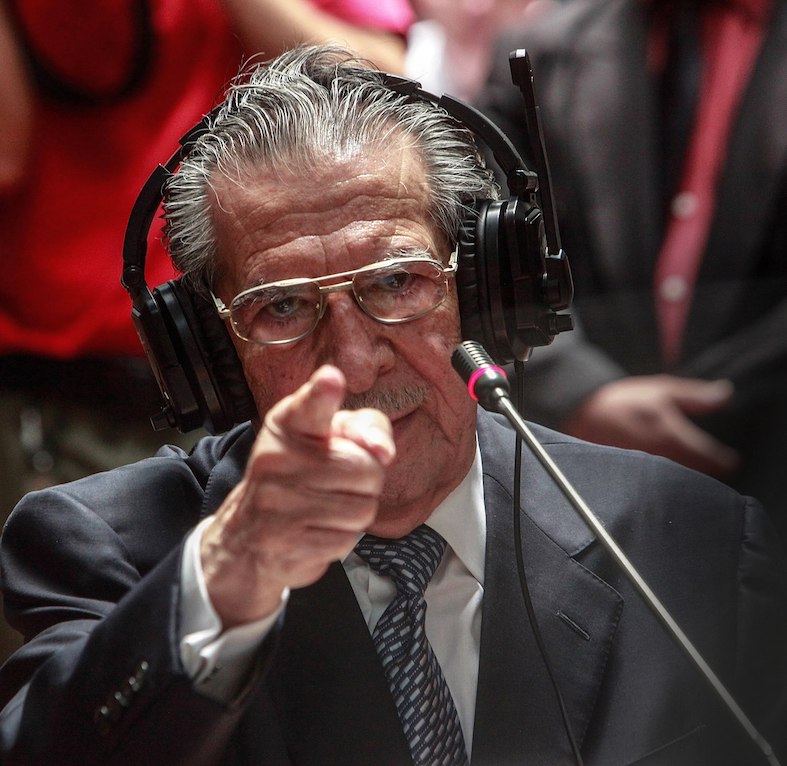 Death DeathRíos Montt died of a heart attack at his home in Guatemala City on April 1, 2018, at the age of 91.[93][94][95] The then incumbent president of Guatemala, Jimmy Morales, expressed his public condolences over the death of General Ríos Montt.[96] In media and popular culture Pamela Yates directed When the Mountains Tremble (1983), a documentary film about the war between the Guatemalan Military and the Mayan Indigenous population of Guatemala. Footage from this film was used as forensic evidence in the Guatemalan court for crimes against humanity, in the genocide case against Efraín Ríos Montt.[97] Granito: How to Nail a Dictator (2011) by Pamela Yates, is a follow-up to When the Mountains Tremble.[98][99][100] The University of Southern California's Shoah Foundation, funded by director Steven Spielberg, is undertaking an extensive analysis of the genocidal Guatemalan civil wars, documented by hundreds of filmed interviews with survivors.[101] The 2019 Guatemalan horror film La Llorona features a character named Enrique Monteverde, based on Ríos Montt. ︎El Buen Cristiano / The Good Christian D - L |
人道に対する罪 主な記事 グアテマラ虐殺 カトリック教会が主催する歴史的記憶回復のための教区間プロジェクト(REMHI)と、1996年の和平合意の一環として国連が共催した歴史解明委員会 (CEH)は、1960年から1996年のグアテマラ内戦中に行われた重大な人権侵害を文書化した報告書を作成した。この戦争は、マルクス主義の反政府勢 力と、グアテマラ軍を含むグアテマラ国家とが対立したものであった。REMHIとCEHの報告書は、暴力のほとんどがグアテマラ国家と政府の支援を受けた 決死隊によって行われたことを明らかにした。この暴力の犠牲者はグアテマラの先住民であるマヤ系住民に偏っていたため、CEHの報告書は、リオス・モント の大統領在任中に大幅に計画され進められた反乱キャンペーンには、意図的な「大量虐殺行為」が含まれていたと特徴づけている[64][65][66]。 REMHIとCEHの報告書は、人道に対する罪とジェノサイドのためにリオス・モントらに対して起こされた法的措置の基礎となった。リオス・モントは、大 統領および最高司令官としての任期中にグアテマラ軍によって犯罪が行われたことは認めたが、それらの行動を計画したり命令したりしたことや、ジェノサイド に相当しうる先住民を標的にする意図的な政策が政府によって行われたことは否定した[67][68]。 1998年、エフライン・リオス・モントの弟であるマリオ・エンリケ・リオス・モントは、殺害された司教フアン・ジェラルディの後任として、グアテマラ大 司教区の人権事務所の所長となった。同事務所は、リオス・モント将軍の政権時代を含め、グアテマラ内戦中に国家によって行われた人権侵害を糾弾する上で主 導的な役割を果たした。 スペインにて 1999年、グアテマラのノーベル平和賞受賞者リゴベルタ・メンチューは、スペインのAudiencia Nacionalに拷問、ジェノサイド、不法拘束、国家が支援したテロリズムの告発状を提出し、被告としてリオス・モントと他の4人の退役グアテマラ将軍 (うち2人は元大統領)を挙げた[69]。正義と説明責任センター(Center for Justice and Accountability)とエスパーニャ人権擁護協会(Asociación Pro Derechos Humanos de España)は、メンチュの提訴に加わった。2005年9月、スペインの憲法裁判所は、たとえ被害者がスペイン人でなくても、スペインの裁判所は人道に 対する罪で告発された人々を裁くことができるという判決を下した。 2006年6月、スペインのサンティアゴ・ペドラズ判事はグアテマラに赴き、リオス・モントと他の被告を尋問した。2006年7月7日、ペドラズはエフラ イン・リオス・モント[71]、オスカル・ウンベルト・メヒア・ビクトレス元大統領、ロメオ・ルーカス・ガルシア元大統領(後者は2006年5月にベネズ エラで死去)に対する国際逮捕状を発行した。退役将軍ベネディクト・ルーカス・ガルシアとアニバル・ゲバラにも令状が出された。現在も逃亡中のドナルド・ アルバレス・ルイス元内務大臣、ジェルマン・チュピナ・バラホナ元警察署長、ペドロ・ガルシア・アレドンド元警察署長も国際逮捕状で指名されている。これ らの逮捕状の一部は当初グアテマラの裁判所によって認められたが、最終的に2007年12月に同国の憲法裁判所によってすべて無効とされた[72]。 グアテマラにおいて 2007年1月17日、リオス・モントは年内に行われる選挙で下院議員に立候補すると発表した。彼は9月の選挙で議席を獲得し、新議会でFRGの15人の 議員を率いた[74]。 リオス・モントの免責は任期満了の2012年1月14日に終了した。2012年1月26日、彼はグアテマラ・シティの裁判所に出廷し、クラウディア・パ ス・イ・パス検事総長によって、他の3人の元将軍とともにジェノサイドと人道に対する罪で正式に起訴された[1]。2012年3月1日、グアテマラ内戦の 過程で犯した政治的・一般的犯罪に対する恩赦を認めた1996年の国家和解法では、リオス・モントに対する罪状は適用されないとの判決が下された[75] [76]。 [77] 2013年1月28日、ミゲル・アンヘル・ガルベス判事は、リオス・モントとホセ・マウリシオ・ロドリゲス・サンチェス退役将軍に対する、ジェノサイドと 人道に対する罪、特に子供を含む1,771人のマヤ・イクシル・インディアンの殺害に対する公判前審問を開始した[78][79]。 法廷でのエフライン・リオス・モント リオス・モントは2013年3月19日にこれらの罪状で裁判にかけられ、元国家元首が自国内でジェノサイドの罪で裁かれた初めてのケースとなった [80]。裁判は2013年4月19日、グアテマラ最高裁判所からの指示に従い、キャロル・パトリシア・フローレス判事によって中断された。判事は、退役 将軍が戦争犯罪で起訴される前の2011年11月まで法的手続きを後退させるよう命じた[81]。 2013年5月10日、リオス・モントはジェノサイドと人道に対する罪で有罪判決を受け、禁固80年の判決を言い渡された[82]。 判決を発表したアイリス・ヤスミン・バリオス・アギラール判事は、「被告はジェノサイドの犯罪を首謀した責任がある」と宣言した[83]: 「イシル人が受けた行為はジェノサイドの犯罪を構成すると確信する...リオス・モントは何が起きているかを知っていたが、それを止めるために何もしな かった」[84]。イクシル人に対する暴力行為は自然発生的なものではなかった。事前に計画されていた」[82]。イリス・ヤスミン・バリオス・アギラル 判事は、イシル族の5.5%が軍隊によって一掃されたという証拠に言及した[85]。 2013年5月20日、グアテマラの憲法裁判所は、手続きの一部において効果的な弁護が認められていなかったという理由でリオス・モントの有罪判決を覆し た[86]。人類学者のデイヴィッド・ストールは、リオス・モントの大統領の下で軍隊によって多数の罪のない市民が殺害されたことは認めるものの、 2013年の裁判の公正さとジェノサイドの罪の根拠の両方に疑問を呈した[87]。 リオス・モント将軍の再審は2015年1月に開始されたが[88]、後に裁判所は、審理は公開されず、被告の年齢と身体的・精神的状態の悪化を理由に刑の 執行はできないと裁定した。 [89][90]2018年4月にリオス・モントが死亡したときには再審は完了しておらず、そのため裁判所は彼に対する裁判を終結させた[91]。 彼の共同被告人である元軍事情報部長のホセ・マウリシオ・ロドリゲス・サンチェスは、裁判所はグアテマラ軍の対反乱戦略が大量虐殺に相当すると認定したも のの、2018年9月に無罪となった[91][92]。 死去 リオス・モントは2018年4月1日にグアテマラ・シティの自宅で心臓発作のため91歳で死去した[93][94][95]。当時のグアテマラ現職大統領 ジミー・モラレスはリオス・モント将軍の死に対して公式に哀悼の意を表明した[96]。 メディアと大衆文化 パメラ・イェーツは、グアテマラ軍とグアテマラのマヤ先住民との戦争を描いたドキュメンタリー映画『When the Mountains Tremble』(1983年)を監督。この映画の映像は、エフライン・リオス・モントに対するジェノサイド事件において、グアテマラの法廷で人道に対す る罪の法医学的証拠として使用された[97]。 パメラ・イェーツによる『グラニト:独裁者を釘付けにする方法』(2011年)は、『山が震えるとき』に続く作品である[98][99][100]。 南カリフォルニア大学のショア財団は、スティーヴン・スピルバーグ監督の資金提供を受けて、生存者との何百ものインタビュー映像によって記録された、大量 虐殺を行ったグアテマラ内戦の広範な分析に取り組んでいる[101]。 2019年のグアテマラ・ホラー映画『ラ・ジョローナ』には、リオス・モントをモデルにしたエンリケ・モンテベルデというキャラクターが登場する。 When the Mountains Tremble |
| History of Guatemala Guatemala National Police Archives |
|
| https://en.wikipedia.org/wiki/Efra%C3%ADn_R%C3%ADos_Montt |
|
| Gospel Outreach was a Christian
Church which emerged in Northern California in 1970 as part of the
Jesus movement.[1] Originally located at Table Bluff, in Humboldt
County, California, 4.5 miles (7.2 km) south of Fields Landing, at an
elevation of 318 feet (97 m) on a bluff adjacent to the Pacific
Ocean,[2] the local movement still exists with a school and Church in
Eureka, California which was completed in 2009.[3] |
ゴスペル・アウトリーチは、1970年にジーザス・ムーブメントの一環
として北カリフォルニアに誕生したキリスト教会である[1]。もともとはカリフォルニア州フンボルト郡のテーブル・ブラフ、フィールズ・ランディングの南
4.5マイル(7.2キロ)、太平洋に隣接する断崖絶壁の標高318フィート(97メートル)に位置していた[2]。2009年に完成したカリフォルニア
州ユーレカの学校と教会とともに、この地域のムーブメントは現在も存在している[3]。 |
| Lighthouse Ranch During the 1960s, members of the hippie counterculture sought a simple life; many were drawn to areas away from large cities and getting back to the land. The Lighthouse Ranch was an abandoned Coast Guard station occupying 8 acres (32,000 m2) of coastal land 11 miles south of Eureka, California. It was situated on the hippie trail that then extended along the west coast of California.[4] The ranch was purchased by Norman Kenneth Smith, an evangelical minister, who converted it to a Christian commune. In 1971, Jim Durkin, a local pastor and real estate agent, formed Gospel Outreach to purchase the ranch from Ken Smith. It became a stopover for young adults seeking spiritual direction.[5][6] Young travelers visited and many stayed, immersing themselves in Bible study, prayer and worship. They also attended services at Deliverance Temple, the church that Jim Durkin pastored in Eureka. They worked in the vegetable garden on the land, and at various other enterprises. In addition to the existing Coast Guard buildings, they built at least one alternative dwelling on the cliffside overlooking the ocean. Building plans were published in the Whole Earth Catalog as part of the Back-to-the-land movement.[7][citation needed] |
ライトハウス・ランチ 1960年代、ヒッピー・カウンターカルチャーのメンバーはシンプルな生活を求めていた。その多くは大都市から離れ、土地に戻ることに惹かれていた。ライ トハウス・ランチは、カリフォルニア州ユーレカの南11マイルにある8エーカー(32,000平方メートル)の海岸沿いの土地にある、放棄された沿岸警備 隊基地だった。この牧場は福音派の牧師ノーマン・ケネス・スミスによって購入され、キリスト教のコミューンに改造された。1971年、地元の牧師で不動産 業者のジム・ダーキンは、ゴスペル・アウトリーチを結成し、ケン・スミスから牧場を購入した。この牧場は、スピリチュアルな方向性を求める若者たちが立ち 寄る場所となり[5][6]、多くの若者たちが訪れ、聖書の研究、祈り、礼拝に没頭し、滞在した。彼らはジム・ダーキンがユーレカで牧会していた教会、デ リヴァランス・テンプルの礼拝にも出席した。彼らは土地にある菜園で働き、その他さまざまな事業で働いた。既存の沿岸警備隊の建物に加え、彼らは海を見下 ろす崖の中腹に、少なくとも1軒の別の住居を建てた。建築計画は「大地に帰る」運動の一環として『ホール・アース・カタログ』に掲載された[7][要出 典]。 |
| Church growth By 1972, Gospel Outreach Lighthouse Ranch had grown to almost 300 members.[1] In keeping with its name, Gospel Outreach began sending missionary teams throughout the world. Throughout the 1970s and 80's, the organization established churches in Palmer, Alaska; Chicago, Illinois; Brooklyn, New York; Silverton, Oregon; and Philadelphia, Pennsylvania. Teams were also sent to Germany, United Kingdom, Nicaragua, Brazil, and Hawaii.[1] With 100 affiliated churches worldwide the Gospel Outreach network became one of the denominational legacies of the Jesus People Movement.[1] |
教会の成長 1972年までに、ゴスペル・アウトリーチ・ライトハウス・ランチは300人近い会員を抱えるまでに成長した[1]。ゴスペル・アウトリーチは、その名前 にふさわしく、世界中に宣教師チームを派遣し始めた。1970年代から80年代にかけて、ゴスペル・アウトリーチはアラスカ州パーマー、イリノイ州シカ ゴ、ニューヨーク州ブルックリン、オレゴン州シルバートン、ペンシルバニア州フィラデルフィアに教会を設立した。また、ドイツ、イギリス、ニカラグア、ブ ラジル、ハワイにもチームが派遣された[1]。世界中に100の関連教会を持つゴスペル・アウトリーチのネットワークは、ジーザス・ピープル・ムーブメン トの教派的遺産の一つとなった[1]。 |
| Central message In the 1970s Jim Durkin preached "God's Purpose And Vision" in sermons, books and television and radio broadcasts. God's purpose, according to Durkin, was to exalt Jesus Christ in all creation. And to accomplish this, He instilled in believers His vision--to preach the gospel throughout the world. Durkin also emphasized repentance, as in a need for a follower of Christ to experience a "turning away' from past wrongful behaviors. This concept was readily understood by young people who had recently identified themselves as hippies.[8] Durkin emphasized the importance of considering the needs of others first, and the personal growth of each individual.[9] The name "Gospel Outreach" reflected the words of Jesus, "And he said unto them, Go ye into all the world, and preach the gospel (good news) to the whole creation."[10] |
中心的メッセージ 1970年代、ジム・ダーキンは説教、著書、テレビ・ラジオ放送で「神の目的とビジョン」を説いた。ダーキンによれば、神の目的は、すべての被造物におい てイエス・キリストを称揚することであった。そして、それを達成するために、神は信者に神のビジョンを教え込まれた--世界中に福音を宣べ伝えることであ る。ダーキンはまた、悔い改め、すなわちキリスト信者が過去の誤った行動から「立ち返る」必要性を強調した。この概念は、最近ヒッピーと呼ばれるように なった若者たちにも容易に理解された[8]。 「ゴスペル・アウトリーチ」という名前は、イエスの言葉を反映したものである。 |
| https://en.wikipedia.org/wiki/Gospel_Outreach_(Humboldt) |
|
| Efraín
Ríos Montt, (born June 16, 1926, Huehuetenango, Guatemala—died April 1,
2018, Guatemala City), Guatemalan army general and politician who ruled
Guatemala as the leader of a military junta and as dictator (1982–83).
In 2013 he was tried by a Guatemalan court on charges of genocide and
crimes against humanity, marking the first time that a former head of
government was prosecuted for such crimes in a national, rather than
international, court. His conviction and sentence of 80 years in prison
were subsequently overturned by Guatemala’s Constitutional Court. Military officer and lay preacher Ríos Montt joined the Guatemalan army in 1943 and rose to the rank of brigadier general and army chief of staff. After serving as director of the Inter-American Defense College in Washington, D.C., in 1973, he returned to Guatemala and ran unsuccessfully for president as the candidate of the National Opposition Front (Frente Nacional de Oposición; FNO) in 1974. He was subsequently dispatched to Spain as a military attaché, which many observers interpreted as a form of forced, if paid, exile. In 1978 he found himself attracted to the evangelical teachings of the California-based Christian Church of the Word (Iglesia Cristiana del Verbo). Under Pres. Fernando Romeo Lucas García’s new government (1978–82), he was allowed to return home. Back in Guatemala, he renounced his Roman Catholic faith and became a lay preacher. The Bible had become his textbook, and Ríos Montt believed that trust in “God, my master and my lord,” alone would conquer the iniquities of political parties, which he came to regard as “sick” and “miserable” species. Dictatorship On March 23, 1982, a coup led by young officers overthrew Lucas García’s government, which they accused of corruption and vote rigging. Although Ríos Montt himself did not actively participate in the coup, he was persuaded to lead a three-man military junta with Gen. Horacio Maldonado Shaad and Col. Francisco Gordillo Martínez. In June, Ríos Montt ousted the two other members of the junta to assume complete dictatorial powers. The U.S. government initially welcomed the change of regime. Following the coup, the Ronald Reagan administration praised Ríos Montt for dealing effectively with corruption and political instability. Claiming that the new government had improved the human rights situation in Guatemala and eager to support its fight against leftist guerrillas, the Reagan administration in 1983 lifted an arms embargo that had been imposed by the Carter administration because of human rights violations. Ríos Montt’s rule also received the moral and financial support of American evangelical Christians, including the televangelist Pat Robertson. Ríos Montt’s initial promises of a return to “authentic” democracy proved empty. Corruption in the civil service was reduced, but violations of human rights continued relentlessly in the then two-decade-long civil war, which pitted the Guatemalan army against leftist guerrillas. The Ríos Montt administration established special military courts that had the power to impose the death penalty on alleged guerrillas and terrorists. The number of killings in the country escalated, and the campaign known as frijoles y fusiles (“beans and rifles”), initiated in an attempt to win over the large Indian population to army rule, resulted in widespread fear; many Indians fled over the border into southern Mexico. Already in 1982 humanitarian organizations were attempting to alert the outside world of massacres of thousands of Indian villagers and other atrocities by the Guatemalan army. Ríos Montt’s counterinsurgency strategy entailed indiscriminate attacks on the Indian communities that allegedly supported the guerrillas. Ríos Montt soon became widely unpopular. He was disliked by many Catholics, who constituted the vast majority of Guatemala’s population, for his evangelical Protestant faith and for his refusal to grant clemency to six guerrillas during the visit of Pope John Paul II. The military was offended by his promotion of young officers in defiance of the army’s traditional hierarchy. Much of the middle class was alienated by his unsuccessful economic policy and his decision to introduce a value-added tax, never before levied in Guatemala. On August 8, 1983, Ríos Montt was deposed in a military coup led by Gen. Óscar Humberto Mejía Victores. Later political career In 1994 Ríos Montt was elected to the Guatemalan Congress in August and became the president of the legislative chamber in December (1994–96; 2000–03). In 2003 he ran unsuccessfully for the presidency after years of being legally prohibited from pursuing the office (the ban was lifted by the Constitutional Court). In 2004 a judge ordered him to be put under house arrest in connection with his alleged involvement in the death of a journalist during a pro-Ríos Montt riot, but the charges were dropped in 2006. He was once again elected to Congress in 2007, and he retired in 2012, having failed to win another term. Legal difficulties Accused of genocide and crimes against humanity, Ríos Montt was put under house arrest in January 2012 and formally indicted in March 2012. After a trial of nearly two months, he was convicted in May 2013 of having orchestrated a counterinsurgency campaign that led to the deaths of nearly 1,800 Maya Ixil Indians and the forced displacement of tens of thousands of others and of having allowed other crimes such as torture and rape to be committed with impunity. Ten days later, however, the Constitutional Court annulled the conviction of Ríos Montt for genocide on the basis of procedural irregularities and ordered a retrial. In October 2013 the same court ruled that Ríos Montt’s actions were exonerated under a general amnesty covering events from March 1982 to January 1986 that had been declared in 1986 by Mejía Victores to cover crimes committed during his own administration and that of Ríos Montt, in which he had served as defense minister. With a challenge to that decision pending, a new trial was scheduled for January 5, 2015. That retrial was then suspended when Ríos Montt’s counsel forced one of the members of the three-judge panel to recuse herself. Earlier in the January proceedings, the national forensic authority had determined that Ríos Montt was healthy enough to attend the trial after he had claimed that he was unfit to do so, and he was taken to the courtroom on a gurney. In July it was Ríos Montt’s mental health that was at issue as the national forensic authority concluded that the now 89-year-old’s cognitive faculties had deteriorated to the point that he was no longer able to understand the charges against him, raising the question of whether the trial, rescheduled for July 23, would be held. In August a panel of psychiatrists charged with evaluating Ríos Montt confirmed the earlier finding that he was suffering from dementia. After various delays and legal rulings, his retrial began in 2017. Because of his declining health, it was closed to the public, and he was not required to attend the proceedings. The trial was ongoing at the time of his death in 2018. |
エ
フライン・リオス・モント(1926年6月16日グアテマラ・ウエウエテナンゴ生まれ-2018年4月1日グアテマラ・シティ没)は、グアテマラの陸軍大
将、政治家で、軍事政権の指導者として、また独裁者(1982-83年)としてグアテマラを統治した。2013年、グアテマラの法廷でジェノサイドと人道
に対する罪の容疑で裁判にかけられ、元政府首脳が国際法廷ではなく国内法廷でこのような罪で訴追された初めてのケースとなった。彼の有罪判決と懲役80年
の判決は、その後グアテマラの憲法裁判所によって覆された。 軍人、信徒説教者 リオス・モントは1943年にグアテマラ陸軍に入隊し、准将、陸軍参謀長にまで昇進した。1973年にワシントンの米州防衛大学長を務めた後、グアテマラ に戻り、1974年に国民野党戦線(Frente Nacional de Oposición; FNO)の候補者として大統領選に出馬したが落選。その後、スペインに駐在武官として派遣されたが、多くのオブザーバーは、これは有給とはいえ強制亡命の 一形態であると解釈した。1978年、カリフォルニアを拠点とするキリスト教会「ことばの教会」(Iglesia Cristiana del Verbo)の福音主義の教えに惹かれる。フェルナンド・ロメオ・ルーカス・ガルシア大統領の新政権(1978-82年)の下、帰国を許される。グアテマ ラに戻った彼は、ローマ・カトリックの信仰を捨て、信徒伝道師となった。聖書が彼の教科書となり、リオス・モントは、「私の主人であり、私の主である神」 への信頼だけが、「病気」で「惨め」な種族と見なすようになった政党の不義に打ち勝つと信じた。 独裁政権 1982年3月23日、若い将校たちによるクーデターが、汚職と不正投票を告発したルーカス・ガルシア政権を打倒した。リオス・モント自身はクーデターに は積極的に参加しなかったが、オラシオ・マルドナド・シャード将軍とフランシスコ・ゴルディージョ・マルティネス大佐との3人による軍事政権を率いるよう 説得された。6月、リオス・モントは他の2人のメンバーを追放し、完全な独裁権力を握った。 アメリカ政府は当初、政権交代を歓迎した。クーデター後、ロナルド・レーガン政権は腐敗と政情不安に効果的に対処したリオス・モントを称賛した。新政権が グアテマラの人権状況を改善したと主張し、左翼ゲリラとの戦いを支援することを熱望したレーガン政権は、1983年、人権侵害を理由にカーター政権が課し ていた武器禁輸を解除した。リオス・モントの統治はまた、テレビ伝道者パット・ロバートソンを含むアメリカの福音派キリスト教徒から道徳的、財政的支援を 受けた。 本物の」民主主義への回帰というリオス・モントの当初の約束は空虚であることが証明された。公務員の汚職は減少したが、グアテマラ軍と左翼ゲリラを戦わせ た当時20年続いた内戦では、人権侵害が容赦なく続いた。リオス・モント政権は、ゲリラやテロリストとされる者に死刑を科す権限を持つ特別軍事法廷を設置 した。国内での殺戮はエスカレートし、インディアンの大群を軍の支配に取り込もうとして始まった「豆とライフル」キャンペーンは、恐怖を広める結果とな り、多くのインディアンが国境を越えてメキシコ南部に逃亡した。1982年にはすでに人道支援団体が、グアテマラ軍による数千人のインディアン村民の虐殺 やその他の残虐行為を外部に知らせようとしていた。リオス・モントの反乱戦略は、ゲリラを支援したとされるインディアン・コミュニティへの無差別攻撃を伴 うものだった。 リオス・モントはすぐに広く不人気となった。福音主義的なプロテスタント信仰を持ち、ローマ法王ヨハネ・パウロ2世の訪問時に6人のゲリラの赦免を拒否し たことで、グアテマラの人口の大半を占める多くのカトリック教徒から嫌われた。軍部は、彼が軍の伝統的な序列に逆らって若い将校を昇進させたことに腹を立 てた。中産階級の多くは、彼の経済政策の失敗と、グアテマラでかつて課税されたことのない付加価値税の導入決定によって疎外された。1983年8月8日、 オスカル・ウンベルト・メヒア・ビクトレス将軍率いる軍事クーデターにより、リオス・モントは退陣した。 その後の政治活動 1994年、リオス・モントは8月にグアテマラ議会議員に選出され、12月には同議会の議長に就任した(1994-96年、2000-03年)。2003 年、大統領選に出馬するも落選し、その後何年間も大統領を目指すことが法的に禁止されていた(憲法裁判所によって禁止は解除された)。2004年、親リオ ス・モント派の暴動でジャーナリストが死亡した事件への関与が疑われ、裁判官から自宅軟禁を命じられたが、2006年に告訴は取り下げられた。2007年 に再び下院議員に当選し、2012年に引退した。 法的困難 大量虐殺と人道に対する罪で告発されたリオス・モントは2012年1月に自宅軟禁され、2012年3月に正式に起訴された。約2ヶ月の裁判を経て、 2013年5月、マヤ・イシル族約1,800人の死者と数万人の強制移住をもたらした反乱作戦を指揮し、拷問やレイプなどの犯罪を容認した罪で有罪判決を 受けた。しかしその10日後、憲法裁判所は手続き上の不正を理由にリオス・モントのジェノサイドの有罪判決を破棄し、再審を命じた。2013年10月、同 裁判所は、メヒア・ビクトレスが1986年に宣言した、1982年3月から1986年1月までの出来事を対象とする一般恩赦により、リオス・モントの行為 は免責されるとの判決を下した。 この決定に対する異議申し立てが係争中であったため、新しい裁判が2015年1月5日に予定されていた。この再審は、リオス・モントの弁護人が3人の裁判 官のうちの1人に退席を強要したため、中断された。1月の審理に先立ち、国家法医学当局は、裁判に出席できないとしていたリオス・モントが十分に健康であ ると判断し、担架で法廷に運ばれた。7月、国の法医学当局が、現在89歳のリオス・モントの認知能力はもはや自分に対する容疑を理解できないほど悪化して いると結論づけたため、問題となっていたのはリオス・モントの精神衛生状態であった。8月、リオス・モントの評価を任された精神科医の委員会は、彼が認知 症に苦しんでいるという以前の所見を確認した。様々な遅延と法的裁定を経て、彼の再審は2017年に始まった。彼の健康状態が悪化しているため、公判は非 公開とされ、彼は手続きに出席する必要はなかった。2018年に彼が亡くなったとき、裁判は継続中だった。 |
| https://www.britannica.com/biography/Jose-Efrain-Rios-Montt |
|
| フェ
ルナンド・ロメロ・ルーカス・ガルシア(前任者) |
|
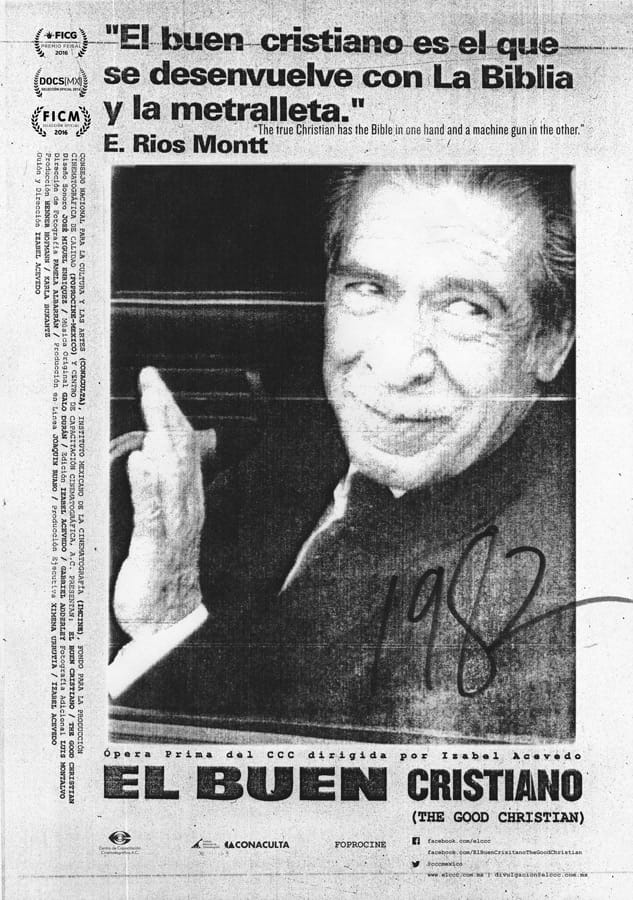 EL
BUEN CRISTIANO - EFRAIN RIOS MONTT (DOCUMENTAL) EL
BUEN CRISTIANO - EFRAIN RIOS MONTT (DOCUMENTAL)Dirección / Director: Izabel Acevedo Producción / Producer: Centro de Capacitación Cinematográfica, A.C. Producción Ejecutiva / Executive Production: Ximena Urrutia, Izabel Acevedo Guión / Screenplay: Izabel Acevedo Fotografía / Cinematography: Pamela Albarrán Edición / Editing: Izabel Acevedo, Gabriel Adderley Sonido / Sound: Axel Muñóz Barba, Joaquin Ruano Diseño de Sonido / Sound Design: José Miguel Enriquez Música / Music: Galo Durán Compañía productora / Production Company: Centro de Capacitación Cinematográfica, A.C. FOPROCINE Reparto / Cast: Francisco Chávez Raymundo, Marta Chávez Raymundo Sinopsis / Synopsis En 1979 José Efraín Ríos Montt renace cuando se convierte al cristianismo. Está dando un sermon a dos alumnos cuando un grupo de soldados irrumpe en su escuela cristiana para pedirle dirigir el golpe de estado de 1982. Francisco Chávez Raymundo y su hermana eran niños pequeños cuando su comunidad fue arrasada a causa de las politicas de Ríos Montt. En marzo de 2013 la vida de Francisco Chavez y Efraín Ríos Montt convergen en el mismo espacio. Llamado por la justicia guatemalteca, Ríos es confrontado por un grupo de huerfanos y viudas de la guerra. Uno de ellos es Francisco. In 1979 José Efraín Ríos Montt became a reborn Christian. He was offering a sermon when a group of soldiers burst into his Christian school, and asked him to lead a military coup in 1982. Francisco Chavez Raymundo and his sister were small children when Rios' political actions annihilated their community. In March, 2013 the lives of Francisco Chavez and Rios Montt converge in the same space. Rios is called upon to testify before Guatemalan justice and is confronted by a group of Mayan Ixiles, orphans and widows of the war, Francisco is one of them. |
 監督/ディレクター:イザベル・アセヴェド 監督/ディレクター:イザベル・アセヴェド製作/プロデューサー:Centro de Capacitación Cinematográfica, A.C. 製作総指揮/製作総指揮:シメナ・ウルティア、イザベル・アセベド 脚本 / 脚本 イザベル・アセヴェド 撮影:パメラ・アルバラン 編集 / 編集:イザベル・アセベド、ガブリエル・アダレイ 音響:アクセル・ムニョス・バルバ、ホアキン・ルアーノ 音響デザイン:ホセ・ミゲル・エンリケス 音楽:ガロ・デュラン 製作会社 / Production Company: Centro de Capacitación Cinematográfica, A.C. フォプロシネ キャスト:フランシスコ・チャベス・レイムンド、マルタ・チャベス・レイムンド あらすじ/概要 1979年、ホセ・エフライン・リオス・モントはキリスト教に改宗し、生まれ変わる。2人の生徒に説教をしていた時、1982年のクーデターを指揮するよ う求める兵士たちがキリスト教学校に乱入する。 フランシスコ・チャベス・レイムンドと彼の妹は、リオス・モントの政策によってコミュニティが壊滅させられたとき、幼い子どもだった。2013年3月、フ ランシスコ・チャベスとエフライン・リオス・モントの人生は同じ空間に収束した。グアテマラの司法制度によって召喚されたリオスは、孤児や戦争未亡人のグ ループと対峙する。その一人がフランシスコである。 1979年、ホセ・エフライン・リオス・モントはキリスト教徒に生まれ変わった。1982年、キリスト教学校に兵士たちが乱入してきたとき、彼は説教を捧 げ、軍事クーデターを指揮するよう要請した。フランシスコ・チャベス・レイムンドと彼の妹は、リオスの政治的行動によって彼らのコミュニティが消滅したと き、小さな子どもだった。 2013年3月、フランシスコ・チャベスとリオス・モントの人生は同じ空間に収束する。リオスはグアテマラの司法の場で証言するよう求められ、マヤのイク シル人、戦争孤児、未亡人のグループと対峙する。 |
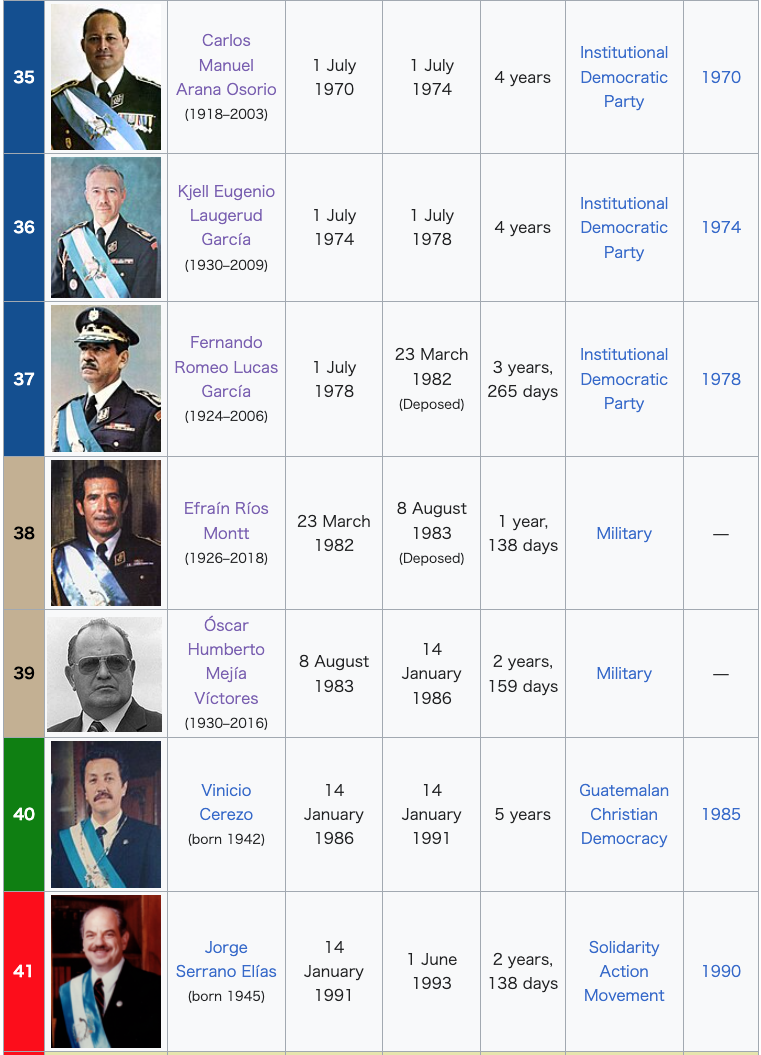
再審中の2018年4月1日に91歳で生涯を終えた。
Copyleft, CC, Mitzub'ixi Quq Chi'j, 1997-2099





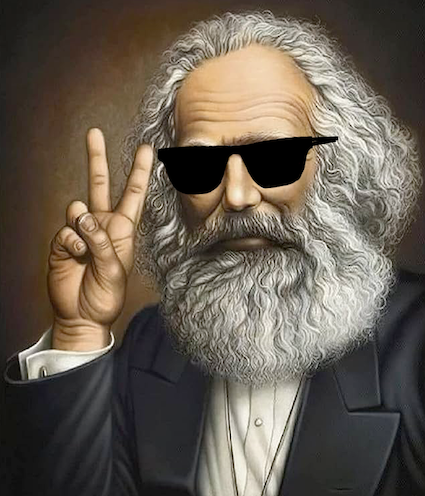
++
☆
 ☆
☆